工具
Koha 的工具都是執行特定工作之用。其他的圖書館管理系統常把這些工具當成 『報表』。
到那裡: 更多 > 工具
Patrons and circulation
讀者清單
Get there: More > Tools > Patrons and circulation > Patron lists
讀者清單是儲存讀者群組的地方,可以經由 批次修改讀者工具 或報表修改讀者。

點選 『新增讀者清單』 鈕,就能新增讀者清單

Enter a list name.
Checking the 『Shared』 box will make this list visible to all users with the manage_patron_lists permission.
Save the list.

每個清單都有 『作用』 鈕以開啟更多選項。

按 『作用』 選單裡的 『新增讀者』 鈕,就能新增讀者入選單。
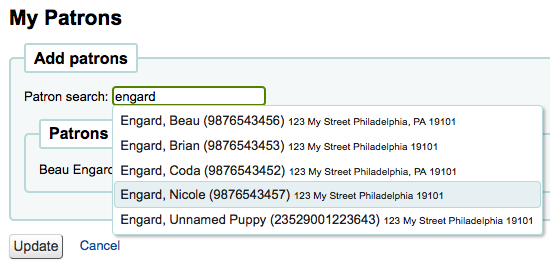
請在搜尋框輸入讀者名字或讀者證號並在右側空白處點擊以加入讀者資訊。
Alternatively, you can click on the 『Enter multiple card numbers』 link and scan (or type in) barcodes in the box.
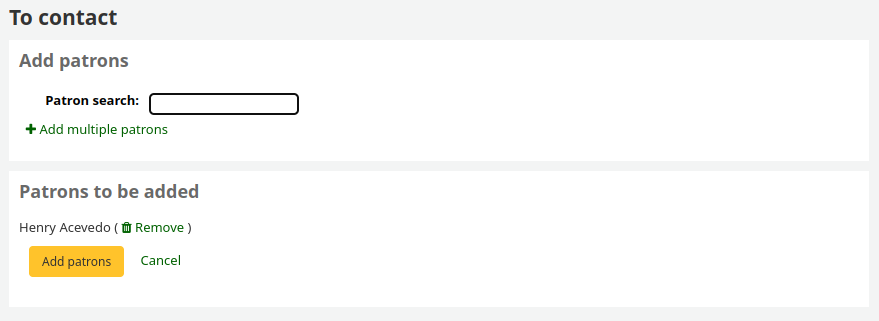
所有的讀者都選定後,按 『新增讀者』 鈕把他們加入清單。
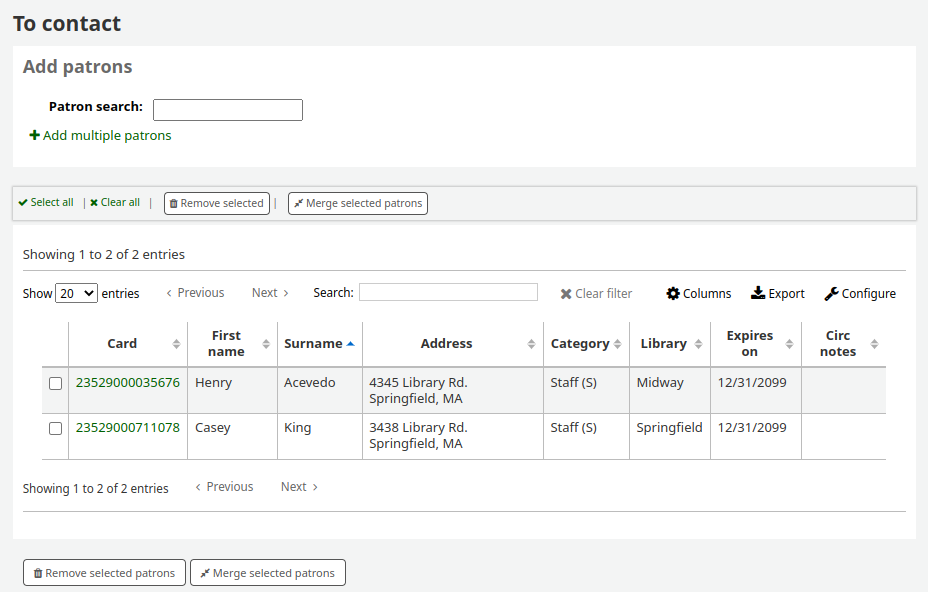
說明
You can customize the columns of this table in the 『Table settings』 section of the Administration module (table id: patron-list-table).
讀者
Get there: More > Tools > Patrons and circulation > Patron clubs
Patron clubs create clubs in which patrons may be enrolled. It is useful for tracking summer reading programs, book clubs and other such clubs.
重要
Staff will need the clubs permissions to edit clubs, templates and enroll patrons. To learn how to set patron permissions, go to the patron permissions section of this manual.
Creating a new club template
Click on the 『New club template』 button. Here you can add fields that can be filled out at the time a new club is created based on the template, or a new enrollment is created for a given club based on the template.
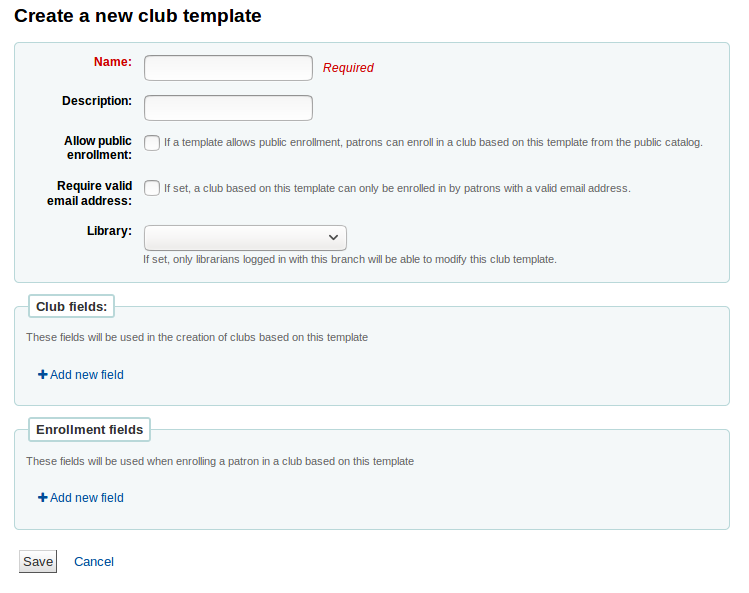
The name is required. This could be something like 『Adult book club』, 『Children’s book club』 or 『Summer reading program』. Remember these templates will be starting point for each club you create.
The description can be any additional information.
Allow public enrollment: if this box is checked it will allow patrons to enroll in a club based on this template from the OPAC.
Require valid email address: if this box is checked only patrons with a valid email address can enroll. So they will need a email address to enroll.
The library drop down gives you the flexibility to let staff from specific branches create clubs with this template. If you let it set to blank, staff from any branch will be able to create a new club using this template.
Club fields: these fields will be used when creating a club based on this template. For example, this can be the name of the club, the name of the animator, the theme, etc.
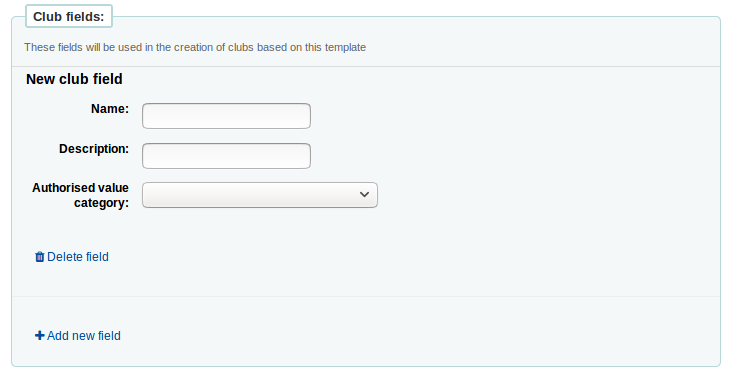
『Name』 is the label of the field
『Description』 is additional information about this field.
You can connect authorized values here.
Enrollment fields: you can add any additional fields you want to have filled out by your patrons when they enroll in a club base on this template.
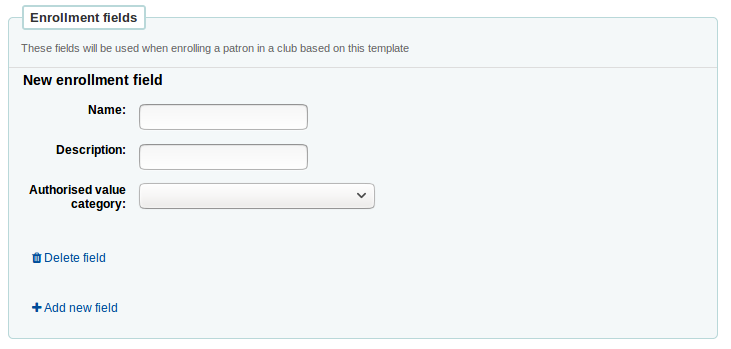
『Name』 is the label of the field
『Description』 is additional information about this field.
You can connect authorized values here.
Creating a new club based on a template
Click on the 『New club』 dropdown menu and select the template you want to use. Here you can add information about a new club using a template you created.

The name is required, this will be the name of the specific club using the template you created. For example, 『Summer 2018 reading club』.
The description can be any additional information.
Start and End date will depict when this club runs, the entire duration of the club. Once the club expires, enrollment will not be possible.
The library drop down gives you the flexibility to enroll patrons from specific branches. If you let it set to blank, patrons from any branch will be able to enroll.
Enrolling a patron in a club from the staff interface
To enroll a patron in a club from the staff client, go to the patron’s account.
On the 『Details』 page or the 『Check out』 page, click on the 『Clubs』 tab. All ongoing clubs will be displayed in this tab.

Click on the 『Enroll』 button and fill in the fields.
You can also cancel enrollment by clicking on the cancel enrollment.
Enrolling a patron in a club from the OPAC
If you allow public enrollment, the club will be visible on the OPAC.
Patrons have to sign into their account. In the 『Your summary』 section, they will be able to click on the 『Clubs』 tab and enroll.
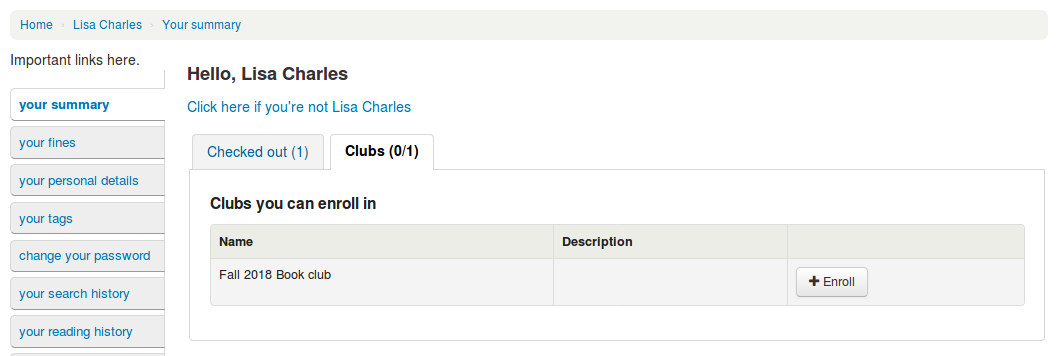
Viewing enrollments
You can monitor the enrollments in each club by going to the 『Patron clubs』 tool page and choosing 『Enrollment』 from the 『Actions』 button.

Placing a hold for a patron club
You can place holds for a patron club - holds are placed for club members in a random order.
To place a hold for a patron club:
Go to the patron clubs tool (『Home > Tools > Patron clubs』).
Click the 『Actions』 button for the club and select 『Search to hold』.
Search for a title and select a record.
Select 『Place hold for [CLUBNAME]』 from either the action links for the record, or from the 『Place hold』 action in the menu bar.
The place holds page is displayed and lists the club members.
Click the 『Place hold』 button.
Result: Holds are placed for all club members.
Patron import
Get there: More > Tools > Patrons and circulation > Import patrons
任何時間都可以使用讀者匯入工具批次新增讀者。通常用於各級學校新生入學時。
Creating a patron import file
You can download a blank CSV file with a header from the start page of the patron import tool that you can use as a template for your patron import. The header contains all fields that can be used with the patron import tool. You can delete fields and columns you don’t need with the exception of a few mandatory ones. When overlaying, if your new .csv includes blank columns, any existing values in patron records will be overwritten with blanks. It is best to remove any blank columns in a .csv to ensure no existing data is removed.
重要
cardnumber, surname, and all fields you have defined in the BorrowerMandatoryField preference are required and must match valid entries in your database.
重要
此 『password』 欄的值必須是純文字,將以 MD5 雜湊演算法編碼。
若密碼已經編碼,請洽系統管理員,詢求其他選項
重要
Date formats should match your dateformat system preference, and must be zero-padded, e.g. 『01/02/2008』. Alternatively you can supply dates in ISO format (e.g. 『2008-12-01』).
重要
If your data contains special characters or diacritics, make sure your file is encoded in UTF-8. Otherwise, the special characters will not be imported correctly.
說明
若載入 讀者屬性,』patron_attributes』 欄位應包括以逗點區隔的屬性類型及其值。
每個值之前應有屬性類型與冒號。
例如:」INSTID:12345,BASEBALL:Cubs」
若設定多個值則此欄位必須折收起來。
因為可能包括空格,所以必須置於雙括號內:
「INSTID:12345,BASEBALL:Cubs,」」BASEBALL:White Sox」」
說明
It’s possible to set restrictions using the patron import tool. If the expiration date and comment match an existing restriction, the one in the import file will be skipped. So a patron import can be repeated multiple times without creating duplicate restrictions. But if one of the criteria is different, a new restriction will be added.
Importing patrons
Once you have created your file, you can use the patron import tool to bring the data into Koha.
選定 CSV 檔案

Choose to match on 『cardnumber』 or 『username』 to prevent adding of duplicate card numbers to the system. Additional matchpoints can be set up using patron attributes marked as unique.
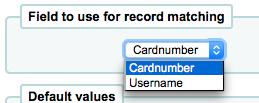
接著選擇適用於匯入讀者的預設值
For example, if you’re importing patrons specific to one branch you can use the field on the import form to apply the branch code to all those you are importing.
Finally, you need to decide on what data you want to replace if there are duplicates.
匹配紀錄是以欄位找到的,避免出現重複紀錄

When using patron attributes in your installation, you can choose how they are handled on import. You can either decide to always overlay all patron attributes or you choose to only replace patron attributes included in your import file. This will leave other attributes untouched.

Notices & slips
Get there: More > Tools > Patrons and circulation > Notices & slips
All notices and circulation receipts (or slips) generated by Koha can be customized using the Notices & slips tool. The system comes with several predefined templates that will appear when you first visit this tool.
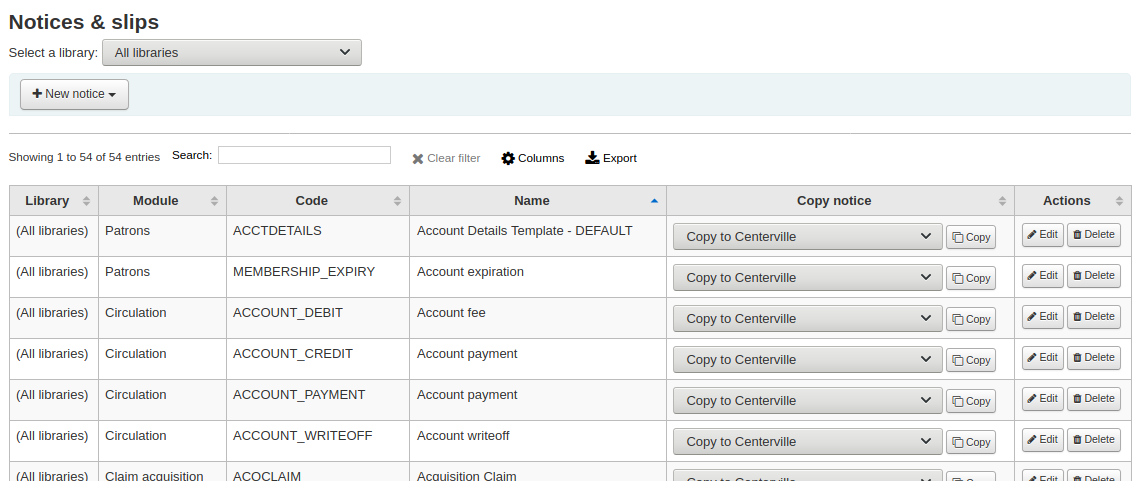
說明
You can customize the columns of this table in the 『Table settings』 section of the Administration module (table id: lettert).
每個通知都可編輯,為了避免系統錯誤,祗有少數才能被刪除。每個通知與收條都可以編輯供各圖書館使用,預設是給所有圖書館使用。
If you have a style you’d like applied to all slips you can point the SlipCSS preference to a stylesheet. The same is true for notices, using the NoticeCSS preference to define a stylesheet.
You will also want to review the Customising notices and slips wiki page for more information on formatting these notices.
Adding notices and slips
新增通知或收條
Click 『New notice』
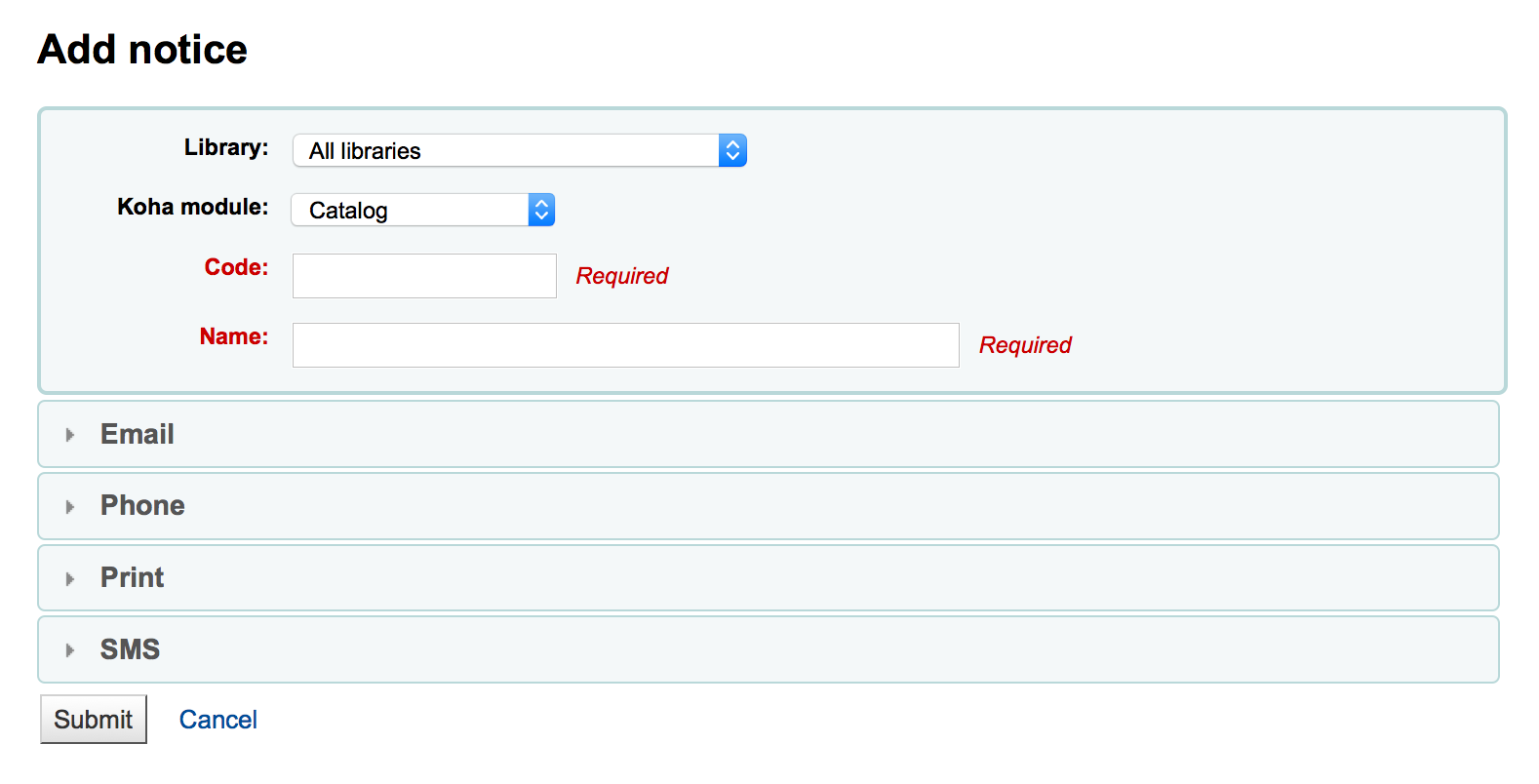
選擇此通知或收條適用的圖書館
重要
Not all notices can be branch specific for more information review the Customising notices and slips wiki page.
選擇此通知相關的模組
代碼限制20字元內
以同樣的欄位擴允您的代碼
說明
使用逾期通知時,確認分館名稱出現其中以及設定 triggers 之內。
接著您可客製化各種可能發送方式的通知
每種通知都應有專屬的電子郵件模板

If you’re using the TalkingTechItivaPhoneNotification service you can set up a Phone notification
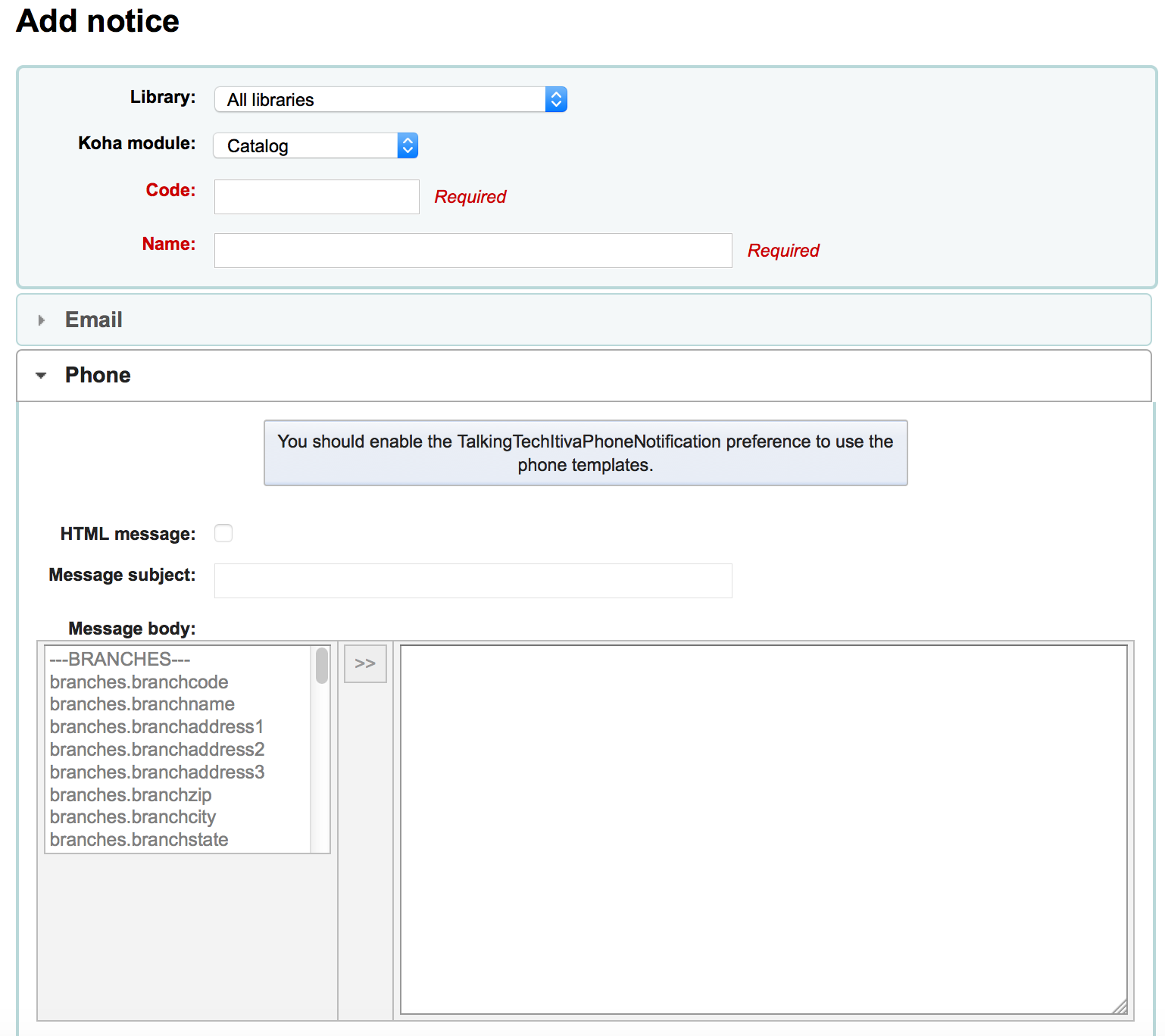
列印此通知時,可以設定列印模板
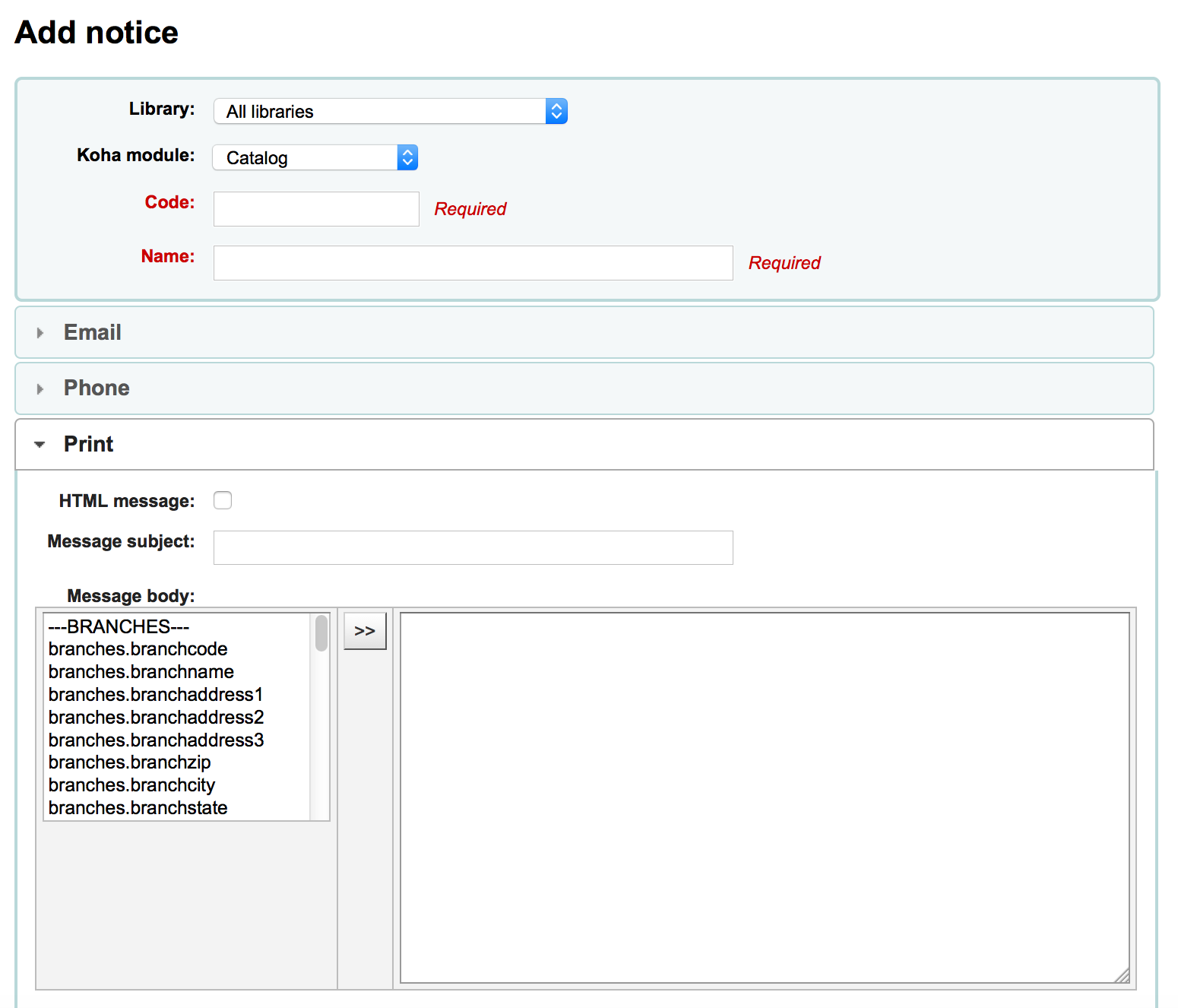
If you have enabled SMS notices with the SMSSendDriver preference you can set the text for your SMS notices next
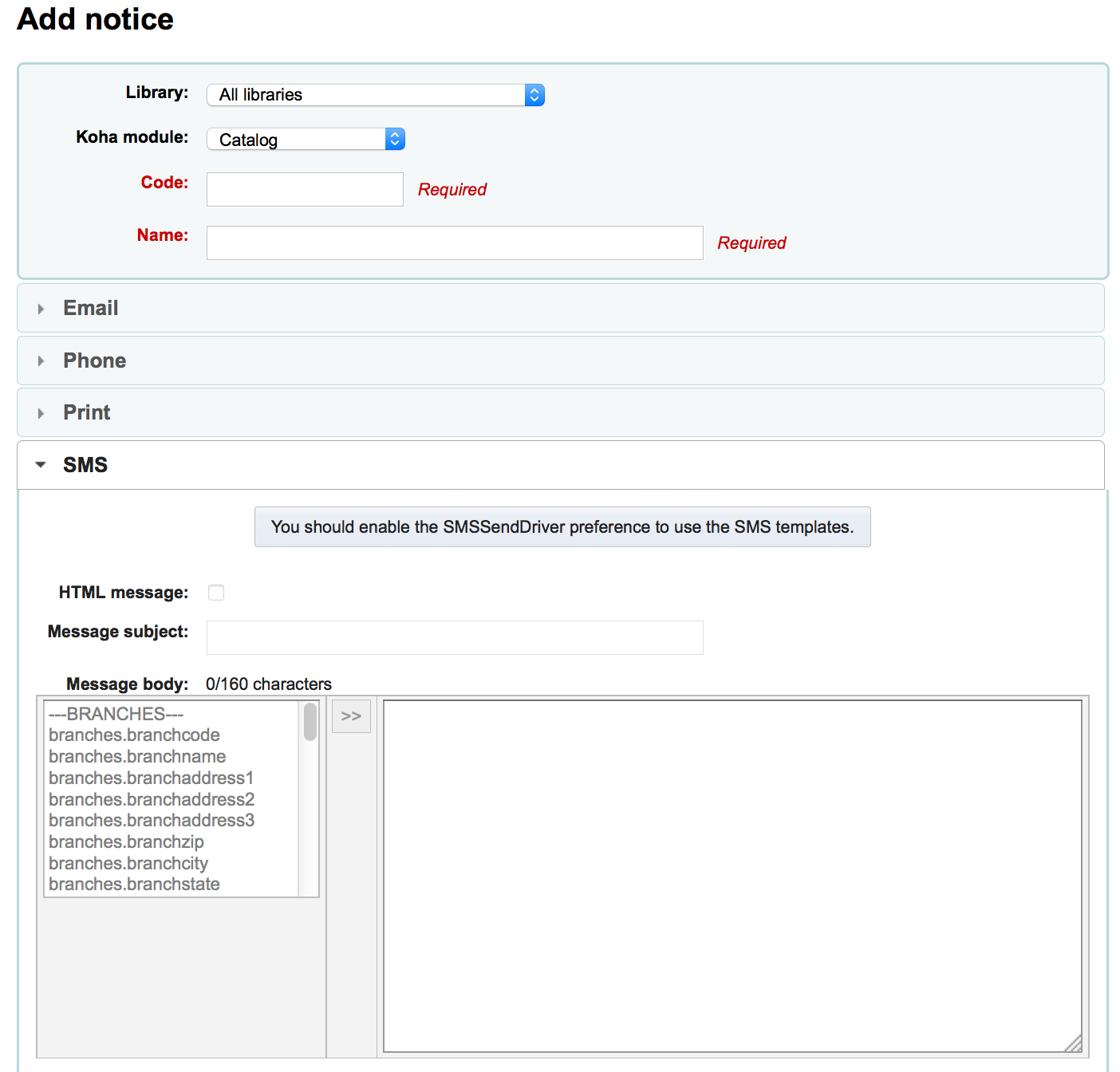
每個通知都有相同的選項
If you plan on writing the notice or slip in HTML check the 『HTML message』 box, otherwise the content will be generated as plain text
Message subject is what will appear in the subject line of the email
可在訊息本體使用任何文字,使用左手邊的欄位鍵入來自資料庫的個人化資料。
說明
Review the Customising notices and slips wiki page for more information.
重要
Overdue notices can use <<items.content>> tags by themselves, or use <item></item> to span all of the tags. Learn more about the Overdue notice markup
確認使用 <<items.content>> 於逾期通知裡,列出所有逾期的館藏資料。
The other option, only for overdue notices, is to use the <item></item> tags to span the line so that it will print out multiple lines. One example for the <item></item> tag option is:
<item>」<<biblio.title>>」 by <<biblio.author>>, <<items.itemcallnumber>>, Barcode: <<items.barcode>> , Checkout date: <<issues.issuedate>>, Due date: <<issues.date_due>> Fine: <<items.fine>> </item>
重要
祗有逾期通知才能使用 <item></item> 標籤,其他的通知使用 <<items.content>>
說明
可使用 <<today>> 語法新增今天的日期
說明
可在其他姓名或縮寫欄位鍵入讀者全名就能在收條或通知內顯示其全名。
The system preference TranslateNotices will add tabs for each installed language to the notices editor. The notice defined in the 『Default』 tab will be used if there is no preferred language set for a patron.

Preview notice templates
For some notices it is possible to preview the notice template showing how it would look to a specified patron for a particular item or record.
If a notice template is previewable the notice template header will contain a field to enter preview data
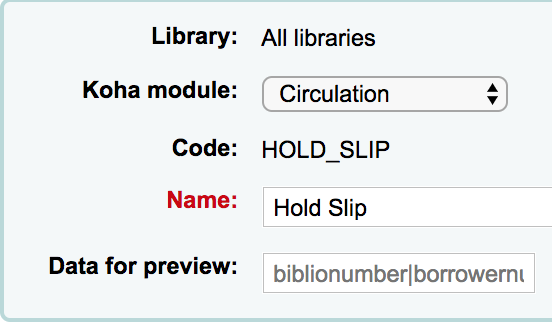
Fill in the necessary information for the template then click the Preview button below the message body. The preview dialog will indicate if there are any problems generating the notice template preview.
Overdue notice markup
When creating your overdue notices there are two tags in addition to the various database fields that you can use in your notices. You will also want to review the Customising notices and slips wiki page for information on formatting item information in these notices.
重要
這些新標籤祗適用於逾期通知,不能用在其他的流通通知。
<item> 與 </item> 應包括來自書目與館藏表的所有欄位。
可使用通知模版裡這些欄號裡的範例:
The following item(s) is/are currently overdue:
<item>"<<biblio.title>>" by <<biblio.author>>, <<items.itemcallnumber>>, Barcode: <<items.barcode>> Fine: <<items.fine>></item>
假設兩筆館藏逾期,通知內容會是這樣:
The following item(s) is/are currently overdue:
"A Short History of Western Civilization" by Harrison, John B, 909.09821 H2451, Barcode: 08030003 Fine: 3.50
"History of Western Civilization" by Hayes, Carlton Joseph Huntley, 909.09821 H3261 v.1, Barcode: 08030004 Fine: 3.50
Existing notices and slips
Among the default notices are notices for several common actions within Koha. All of these notices can be customized by altering their text via the Notices & slips tool and their style using the NoticeCSS preference to define a stylesheet. You will also want to review the Customising notices and slips wiki page for information on formatting item information in these notices. Here are some of what those notices do:
已接受
This notice is sent when a patron’s suggestion is accepted.
Note: If you don’t want to send this notice, just delete it.
ACCOUNT_PAYMENT
This notice is sent for each payment transaction in a patron’s account if the UseEmailReceipts system preference is set to 『Send』.
ACCOUNT_WRITEOFF
This notice is sent for each writeoff transaction in a patron’s account if the UseEmailReceipts system preference is set to 『Send』.
ACQCLAIM (Acquisition claim)
Used for claiming orders in the aquisitions module
ACQCLAIM is the code of the sample notice, but it’s possible to define several notices choosing any code. Only the module 『Claim acquisition』 will be taken into account. All notices with this module will appear in the pull down on the late orders page.
Get there: More > Acquisitions > Late orders
This notice is sent if several criteria are met:
The staff patron triggering the email has a valid email address.
The vendor contact marked as 『Contact about late orders?』 has a valid email address.
ACQORDER (Acquisition order)
Used in the acquisitions module to send order information to the vendor
The notice is triggered manually from the basket summary page using the 『Email order』 button in the toolbar.
This notice is sent if several criteria are met:
The staff patron triggering the email has a valid email address.
The vendor contact marked as 『Primary acquisitions contact』 and 『Contact when ordering』 has a valid email address.
ACQ_NOTIF_ON_RECEIV
Used in the acquisition module to inform patrons on receiving orders they have been added to.
AR_CANCELED
This notice is sent to the patron when an article request is cancelled by staff.
AR_COMPLETED
This notice is sent to the patron when an article request is marked as completed by staff.
AR_PENDING
This notice is sent to the patron when an article request is changed to 『pending』 status
AR_PROCESSING
This notice is sent to the patron when an article request is marked as being processed by staff.
AR_REQUESTED
This notice is sent to the patron when an article request has been made in order to confirm the request.
AUTO_RENEWALS
This notice is sent to the patron if automatic renewals are enabled and the patron has chosen to receive it in their messaging preferences.
In order to send this notice, you must set the AutoRenewalNotices system preference to 「according to patron messaging preferences」.
This notice is set so that, depending on the result of the renewal, whether is was successful or not, the message will be different.
AUTO_RENEWALS_DGST
This notice is sent to the patron if automatic renewals are enabled and the patron has chosen to receive the digest in their messaging preferences.
In order to send this notice, you must set the AutoRenewalNotices system preference to 「according to patron messaging preferences」.
This notice is set so that, depending on the result of the renewal, whether is was successful or not, the message will be different.
AVAILABLE
This notice is sent to the patron who made a suggestion, when the order created from the suggestion is received.
Note: If you don’t want to send this notice, just delete it.
CHECKIN
還入館藏時發送此 『還入』 通知
碰到以下兩種情況時使用此通知:
The EnhancedMessagingPreferences is set to 『Allow』
讀者請求收到此通知
Get there:OPAC > Login > your messaging
Get there:Staff client > Patron record > Notices
CHECKINSLIP
This slip lists all items that were checked in today for this patron
To print this slip, click Print > Print checkin slip from the patron file
You can also print this slip from the Check in page
CHECKOUT
借出館藏時發送此 『借出』 通知
碰到以下兩種情況時使用此通知:
The EnhancedMessagingPreferences is set to 『Allow』
讀者請求收到此通知
Get there:OPAC > Login > your messaging
Get there:Staff client > Patron record > Notices
DISCHARGE
This notice is used to generate a PDF to document a successful discharge request
The PDF can either be downloaded by the patron from their patron account or from the staff interface when discharging a patron
The discharge feature is controlled by the useDischarge system preference.
DUE
館藏到期時發送此 『到期』 通知
碰到以下兩種情況時使用此通知:
The EnhancedMessagingPreferences is set to 『Allow』
讀者請求收到此通知
Get there:OPAC > Login > your messaging
Get there:Staff client > Patron record > Notices
DUEDGST
館藏到期時發送此 『到期』 通知
碰到以下兩種情況時使用此通知:
The EnhancedMessagingPreferences is set to 『Allow』
讀者要求以摘要方式收取此通知
Get there:OPAC > Login > your messaging
Get there:Staff client > Patron record > Notices
HOLD (Hold available for pickup)
碰到以下兩種情況時使用此通知:
The EnhancedMessagingPreferences is set to 『Allow』
讀者請求收到此通知
Get there:OPAC > Login > your messaging
Get there:Staff client > Patron record > Notices
當此通知指向分館表單時,係指提取分館的資訊。
HOLDPLACED (告知館員預約已被取代的通知)
This notice requires the emailLibrarianWhenHoldIsPlaced system preference to be set to 『Enable』
當此通知指向分館表單時,係指提取分館的資訊。
MEMBERSHIP_EXPIRY
此通知告訴讀者其讀者證即將到期。
Requires that you have the MembershipExpiryDaysNotice set and the related cron job set.
NOTIFY_MANAGER
This notice is sent to a staff member when they are assigned as manager of a suggestion in the acquisitions module.
ODUE (Overdue notice)
This notice is used to send overdue notices to patrons
ODUE is the code of the sample notice, but it’s possible to use any code and define multiple different messages for different patron categories and notice levels
Requires that you set Overdue notice/status triggers
ORDERED
This notice is sent to the patron who made a suggestion, when the 『from a suggestion』 option is used to create an order from it.
Note: If you don’t want to send this notice, just delete it.
PASSWORD_RESET
This notice is sent when a patron requests a new password from the OPAC in order to validate the email address.
The password reset feature is controlled by the OpacResetPassword system preference.
PICKUP_RECALLED_ITEM
This notice is sent to the patron who has requested a recall when the item is ready for them to pick up.
PREDUE
此通知當成發送 『到期提前通知』 之用
碰到以下兩種情況時使用此通知:
The EnhancedMessagingPreferences is set to 『Allow』
讀者請求收到此通知
Get there:OPAC > Login > your messaging
Get there:Staff client > Patron record > Notices
PREDUEDGST
此通知當成發送 『到期提前通知』 之用
碰到以下兩種情況時使用此通知:
The EnhancedMessagingPreferences is set to 『Allow』
讀者要求以摘要方式收取此通知
Get there:OPAC > Login > your messaging
Get there:Staff client > Patron record > Notices
已拒絕
This notice is sent when a patron’s suggestion is rejected.
Note: If you don’t want to send this notice, just delete it.
RENEWAL
續借館藏時發送此 『借出』 通知
滿足三種情況時使用此通知:
The EnhancedMessagingPreferences is set to 『Allow』
The RenewalSendNotice preference is set to 『Send』
讀者已要求收取借出通知
Get there:OPAC > Login > your messaging
Get there:Staff client > Patron record > Notices
RETURN_RECALLED_ITEM
This notice is sent to the patron who currently has an item in their possession that has been recalled. It serves to notify them of the new due date for the checked out item.
SERIAL_ALERT (New serial issue)
Notice used in the serials module to notify patrons/staff of new issues of a serial. SERIAL_ALERT (RLIST in older versions) is provided as a sample notice, but the notice code can be chosen freely as only the module is taken into account. Multiple notices can also be managed.
Get there: More > Serials > New subscription
You have the option to select the notice used to inform the patron about a received serial issue for a subscription. Choose from the 『Patron notification』 drop down.
If a notice has been selected for a subscription, patrons can subscribe to the email notification from the subscription tab in the detail view in the OPAC.
說明
按 『設定新通知』 鈕進入 『通知』 工具,就能通知讀者新的期刊到館
SHARE_ACCEPT
通知讀者,其他讀者接受共享虛擬書架。
Requires that you set OpacAllowSharingPrivateLists to 『Allow』
SHARE_INVITE
通知讀者,其他讀者想要共享其虛擬書架。
Requires that you set OpacAllowSharingPrivateLists to 『Allow』
SR_SLIP
Used to notify library staff of a particular branch of items that should be transferred to another branch in the context of stock rotation
Requires the stockrotation.pl
TO_PROCESS
告知館員採訪建議是否移入基金
Requires the notice_unprocessed_suggestions cron job
WELCOME
Sent to patrons when their account is set up if the AutoEmailNewUser preference is set to 『Send』
備註
For security reasons, it is not possible to send the patron’s password in a notice.
There are also a set of predefined slips (or receipts) listed on this page. All of these slips can be customized by altering their text via the Notices & slips tool and their style using the SlipCSS preference to define a stylesheet. Here is what those slips are used for:
AR_SLIP
Used to print a slip for an article request
The slip or receipt can be printed manually when managing article requests from the staff interface.
Get there: Circulation > Article requests > Actions > Print slip
ISSUEQSLIP
使用於流通的快速收條
快速收條祗包括今天借出的館藏
ISSUESLIP
使用於列印流通的完整收條
收條顯示今天借出與尚未還入的館藏
HOLD_SLIP
使用於列印預約收條
The holds slip is generated when a hold is confirmed and set to waiting.
OVERDUE_SLIP
Used to print an overdues slip
The overdues slip can be generated manually using the 『print』 menu in the patron account in staff. It will show all items overdue.
RECALL_REQUESTER_DET
Used to print the details of the patron who has requested a recall on an item.
TRANSFERSLIP
使用於列印快速收條
確認轉移後,列印轉移收條,隨書轉移至另個圖書館
Overdue notice/status triggers
Get there: More > Tools > Patrons and circulation > Overdue notice/status triggers
In order to send the overdue notices that you defined using the Notices & slips tool, you need to first set the triggers to have these messages.
重要
設定需要逾期通知的 讀者類型,才能發送逾期通知給讀者。
重要
Depending on the value of your OverdueNoticeCalendar preference the delay may or may not include days the library is closed based on the holiday calendar.
The Overdue notice/status triggers tool gives the librarian the power to send up to three notices to each patron type notifying them of overdue items

延遲日數是應該到期卻逾期後啟動通知的日數。
重要
必須設定延遲日數,才能要求 Koha 啟動此作業 (送出信件或限制借閱權利)。
勾選分頁的 『第二』 與 『第三』 通知,送出更多的通知
勾選 『限制』 盒,把通知置於讀者紀錄裡,在借出時,告知館員,該讀者還有逾期館藏,不得借出;如此一來,就達到禁止讀者借出館藏的目的。
If you choose to restrict a patron in this way you can also have Koha automatically remove that restriction with the AutoRemoveOverduesRestrictions preference.
Next you can choose the delivery method for the overdue notice. You can choose from Email, Phone (if you are using the iTiva Talking Tech service), Print and SMS (if you have set your SMSSendDriver).
Patron card creator
Get there: More > Tools > Patron card creator
The patron card creator allow you to use layouts and templates which you design to print your custom patron cards on your printer. Here are some of the features of the patron card creator module:
從 Koha 讀者資料取得客製化讀者證布局的文字內容
設計讀者證面板供列印之用(符合書標格式)
建立與管理供批次列印的讀者證
匯出 (PDF 格式) 一件或多件批次列印資料
匯出 (PDF 格式) 一個批次的一件或多件讀者證
布局
Get there: More > Tools > Patron card creator > Manage > Layouts
布局定義印在讀者證的文字與照片位置。
說明
讀者證可使用最多三列文字的條碼,以及最多兩張照片。
Add a layout
若還沒有設定布局,可按螢幕上方的 『新增』 鈕並選擇 『布局』,就能新增它。
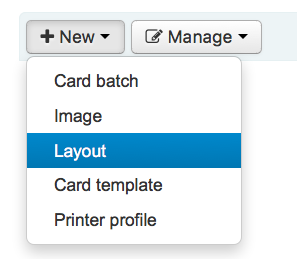
可按左方的 『管理布局』。出垷可供編輯的布局清單。但每頁上方仍有 『新增布局』 鈕。
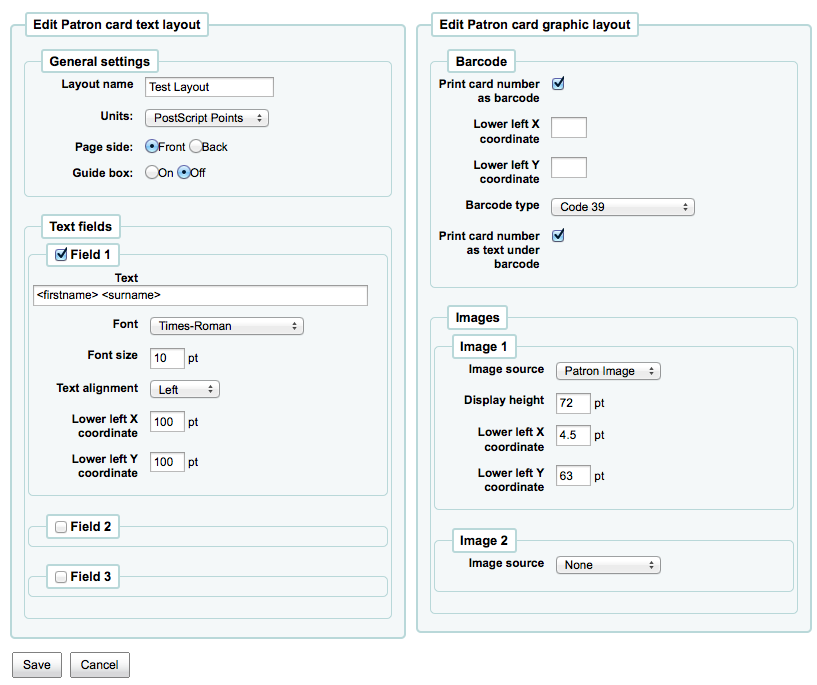
指定給布局的名稱係供您未來容易辨識使用
以下拉選單使用的單位設定在布局內使用的度量的單位。

說明
A Postscript Point is 1/72」, an Adobe Agate is 1/64」, an Inch is 25.4 SI Millimeters
Next, note if this layout is for the front or the back of the patron card
說明
使用 2 面讀者證時需設定正反面的布局,此選項不允許列印雙面讀者證,祗能用於追蹤設計的讀者證。
讀者證最多有 3 列文字。可以是固定的文字或從讀者紀錄提取的欄位內容。把欄位名稱置於方括號內,就能提取欄位的內容 - <firstname>
說明
可從資料庫概要 http://schema.koha-community.org 取得檔案名稱的清單
對每列文字,您需選定字型、大小與讀者證上文字的位置
In order to show the barcode and the patron card number you will need to check the 『Print card number as barcode』 option. This will turn the patron card number into a barcode. If you want the number to print in human readable format you will need to check the 『Print card number as text under barcode』 option.
最後,可選擇兩張以內的照片印在讀者證上。
可以調整 讀者照片 的大小,以符合 Koha 的要求。
The other image can be something like a library logo or symbol that you uploaded using the 『manage images』 module of the patron card creator Tool.
重要
設計者需負責文字、條碼與照片以免重複。
儲存之後,您的布局將出現在 『管理布局』 頁面。
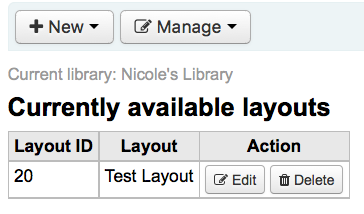
模板
Get there: More > Tools > Patron card creator > Manage > Card templates
布局的作用是在書標/讀者證排列標籤。可能是 Avery 5160 地址機、Gaylord 47-284 書標機或 28371 讀者證製作機等。布局所需的資訊可能在包裝上,或者從代理商的網站或範例取得。
Add a template
按頁面上方的 『新增模版』 就立即進入編輯模版頁面。可按左方的 『管理模版』 鈕。從可得的模版中選取編輯的模版。不過在頁面上方仍有 『新增模版』 鈕。
Using the form that appears after pressing either 『Edit』 or 『New template』 you can define the template for your sheet of labels or cards.
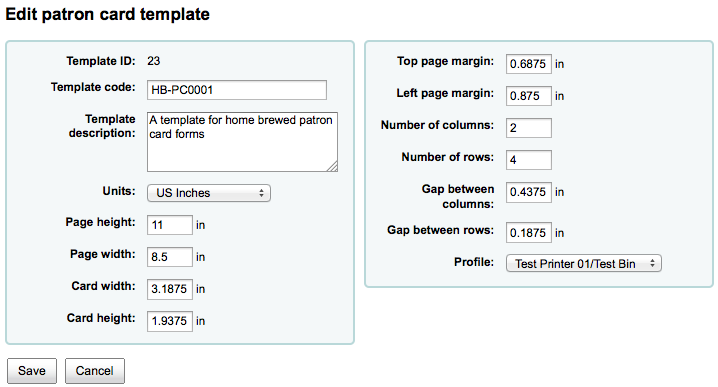
模版代碼是系統產生的代碼
Template code should be the name of this template to identify it on a list of templates
You can use the template description to add additional information about the template
以下拉選單使用的單位設定在布局內使用的度量的單位。

說明
A Postscript Point is 1/72」, an Adobe Agate is 1/64」, an Inch is 25.4 SI Millimeters
度量 (頁高、頁廣、卡片廣、卡片高) 可從包裝取得,也可從代理商網站或樣張量取。
設定檔是一組適用於指定模版的 「調整」,於列印之前補償特定印表機的偏移 (指定給該印表機)。
挑選列印的設定檔前先試印幾張讀者證就能看出印表機/模版組合的可行性。
從印表機文件找到偏移值後,新增設定檔 並指定給模板。
重要
必要時才建置設定檔,不要隨意設定印表機設定檔。不可能移除模版內移除設定檔但可以切換至另個設定檔。
說明
使用不同的印表機則應設定多個模版。
儲存之後,您的布局將出現在 『管理布局』 頁面。

設定檔
Get there: More > Tools > Patron card creator > Manage > Profiles
設定檔是一組適用於指定 模版 的 「調整」 於列印之前補償特定印表機的偏移。設定模版後並列印樣本資料若發現館藏並未出現在預期的位置,對該印表機給個設定檔 (或同個印表機的不同紙匣),指示上、下、左、右的位移值。
印出的讀者證與預期相同,就不需要設定檔。
Add a profile
To add a new profile, you want to click on the 『Profiles』 button at the top of your page and choose 『New profile』
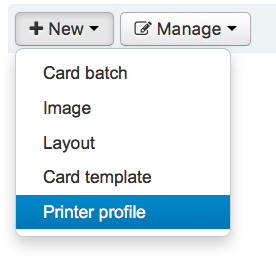
To add a new profile, you want to click on the 『New profile』 button at the top of your page. Using the form that appears you can define the values to correct the card misalignment on your label sheet. You may also choose 『Manage profiles』 on the left side and select one of the currently available profiles for editing.

The Printer name and Paper bin do not have to match your printer exactly, they are for your reference so you can remember what printer you have set the profile for.
說明
例如:可在印表機名稱內使用印表機型號,或者稱他為 『我的桌面印表機』
在 編輯模板表單 選定設定檔後即把內容加入該模板內
單位下拉選單用在您的設定檔內,用以設定衡量的單位。

說明
A Postscript Point is 1/72」, an Adobe Agate is 1/64」, an Inch is 25.4 SI Millimeters
整個圖像水平或垂宜偏離中心就該處理位移。小心描述該偏離的狀況
對偏移值而言,負數表示向上與向左移動內容而正數表示向下與向右
範例:距離第一個標籤左緣 0 .25」,距離第二個標籤左緣 0 .28」 且距離第三個標籤左緣 0 .31」。表示水平偏移應設為 (減) -0.03 」 以補償其差距。
After saving, your profiles will appear on the 『Manage printer profiles』 page.

儲存新的設定檔後,可回到模板清單並選擇編輯該模板。
批次
Get there: More > Tools > Patron card creator > Manage > Card batches
批次是一群讀者,您可批次製作讀者證。
Add a batch
按頁面上方的 『新增批次』,就能新增批次了。選擇左方的 『管理批次』 就可從選單中選取批次。您可從這裡選取待編輯的批次或新增批次。
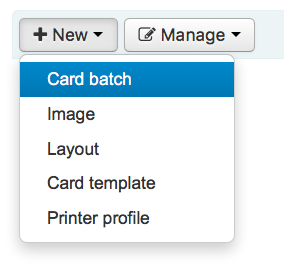
彈出新的批次訊息並指引您選擇被發送的讀者。
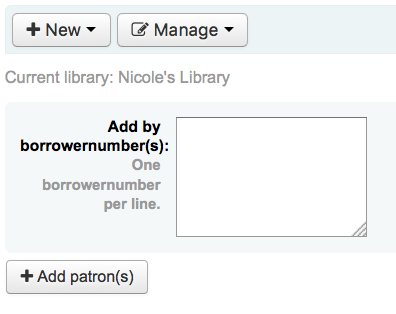
After choosing the 『Add patron(s)』 button the Patron Search window pops up.
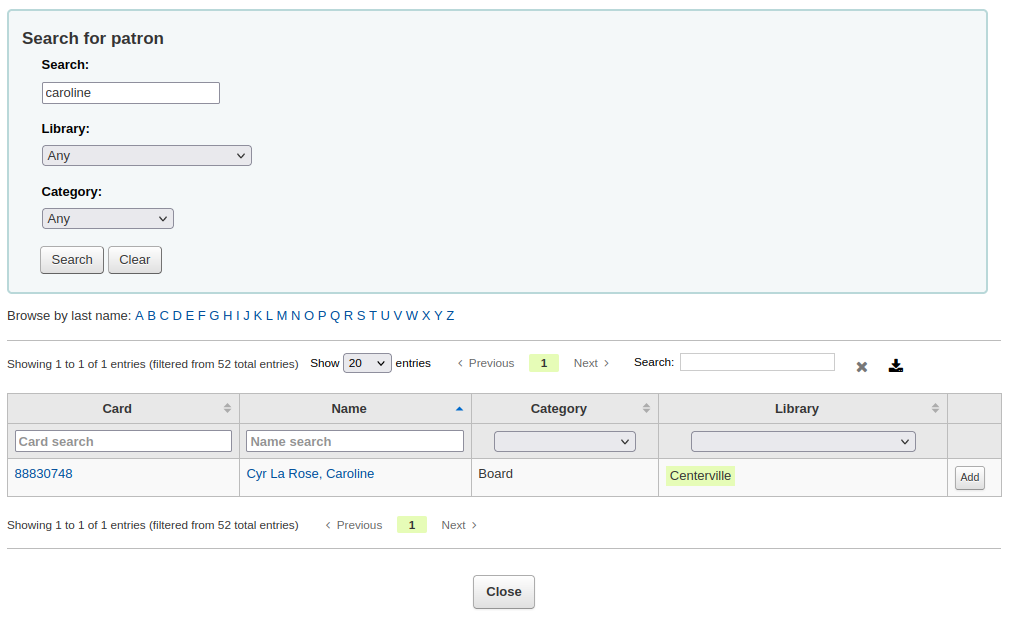
從這裡搜尋讀者姓名、類型或所屬圖書館就能把讀者加入批次內。以萬用字元 * 搜尋所有的讀者。
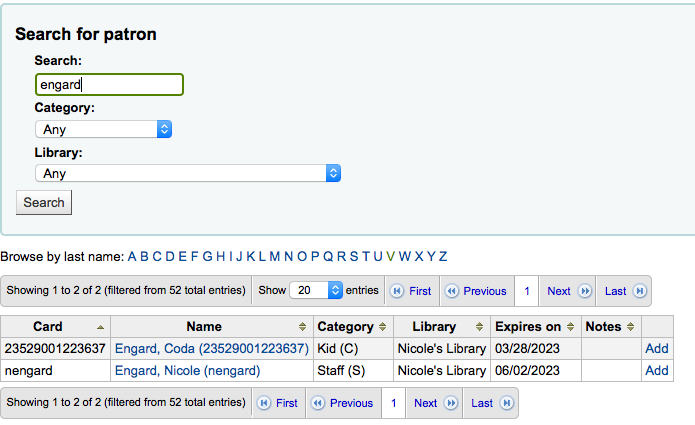
按 『新增』 鈕就能新增讀者至批次。從結果新增讀者後可執行另個搜尋重新來過或按螢幕下方的 『關閉』 鈕表示做完了。然後出現此批次。
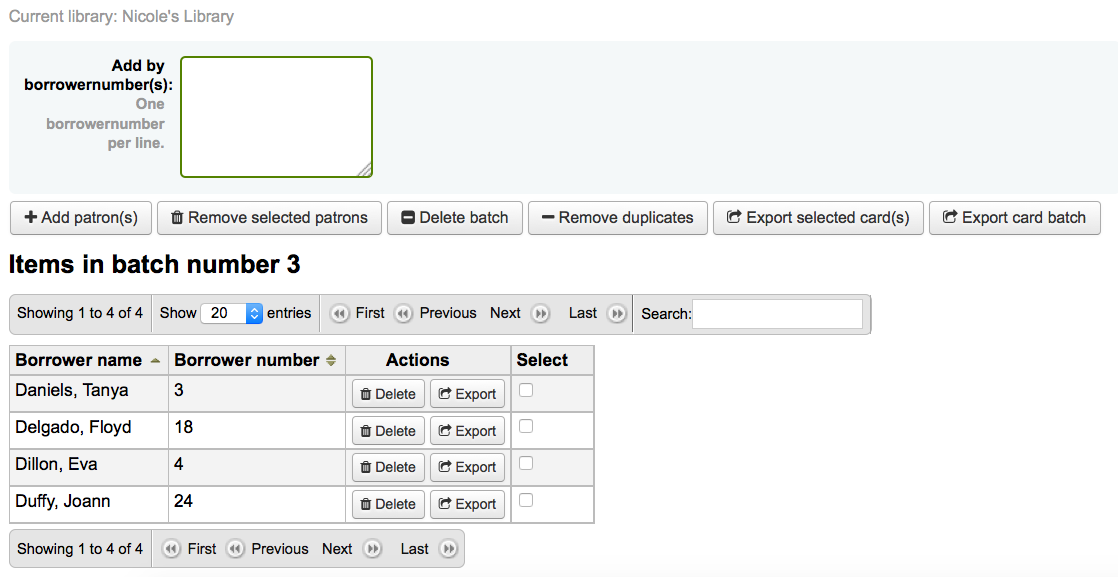 批次編好後就可以匯出。可在螢幕上方找到編修或刪除該批次的鈕。隨時可從 『管理 > 批次讀者證』 鈕回到編修或刪除批次的畫面。
批次編好後就可以匯出。可在螢幕上方找到編修或刪除該批次的鈕。隨時可從 『管理 > 批次讀者證』 鈕回到編修或刪除批次的畫面。
可以按 『批次匯出讀者證』 或勾選讀者名字右方的盒,再按上方的 『匯出讀者證』 鈕,匯出勾選的讀者。
匯出選單請您指定模板、布局與開始位置 (在報表紙開始列印的位置)。
說明
若前 6 個書標已使用則可從第 7 個位置開始列印。書標的位置編碼係由左而右由上而下。

按下 『匯出』 鈕後出現列印書標的 PDF 檔案
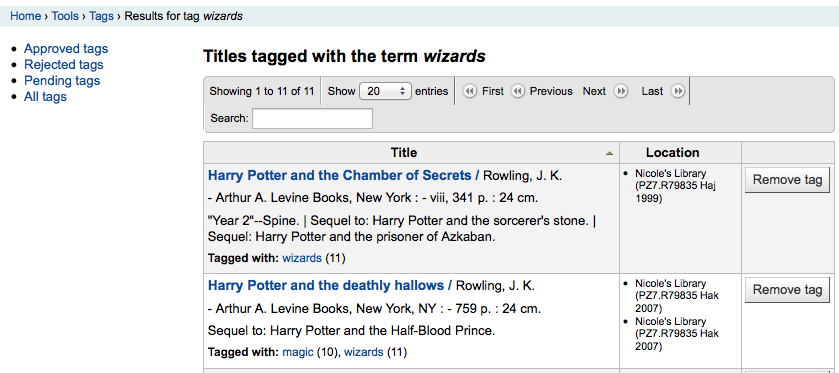
開啟 PDF 檔案後可看到待列印的讀者證

以上的圖像是兩行文字式的布局。第一行是純文字,第二行是兩個欄位的內容 <firstname> <surname>。可以列印讀者照片 (若提供的話) 與 39 碼式的讀者號。以三欄 8 列的模板在位置 1-3 列印。列印時不會重組 PDF (即不會自動符合紙張大小) 印表機可能無法在模板上正確印出。
Manage images
Get there: More > Tools > Patron card creator > Manage > Images
Images uploaded using this tool will appear on the menu when creating patron card layouts. You are limited in how many images you can upload (not counting patron images) by the ImageLimit system preference.
重要
照片必須小於500K。
說明
以此工具上傳的照片不得少於300dpi,這是列印的最低品質。
在螢幕中央是一個簡單的上傳表單,瀏覽電腦的檔案,選定後給個容易辨識的名稱。

檔案上傳後,出現確認訊息。

照片與其他資料將顯示在頁面的右手邊。
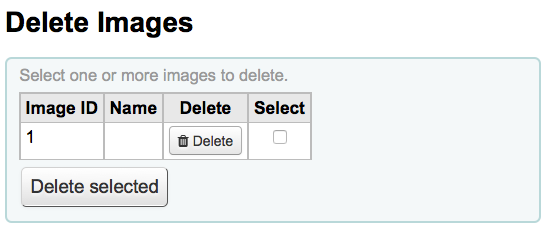
勾選照片右方盒,再按下 『刪除』 鈕,就能刪除照片。
Batch patron deletion/anonymization
Get there: More > Tools > Patrons and circulation > Batch patron deletion/anonymization
此工具允許批次匿名流通紀錄 (圖書館仍保留館藏借出次數的資料 - 但沒有借閱者的資料) 或批次刪除讀者 (從系統裡完全移除)。
重要
不能儲存還有罰款待繳或待還館藏的讀者。不能從系統移除他們 (祗能從 delete_borrowers 表單移除),但此工具不提供其他的選項。
重要
使用此工具前建議先備份資料庫。改變後無法復原。
重要
The anonymization will fail quietly if AnonymousPatron preference does not contain a valid value.
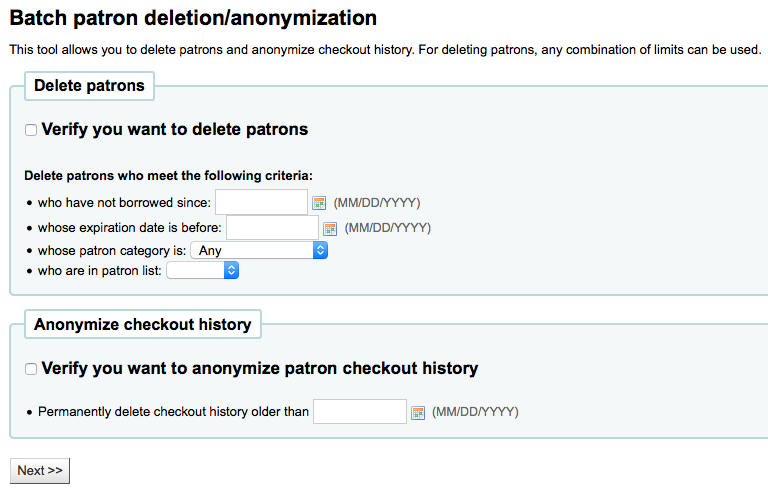
刪除或匿名讀者
批次讀者修改
Get there: More > Tools > Patrons and circulation > Batch patron modification
此工具允許批次編輯讀者記錄。上傳讀者號檔案 (一號一行),選擇 讀者清單 或掃瞄讀者號。
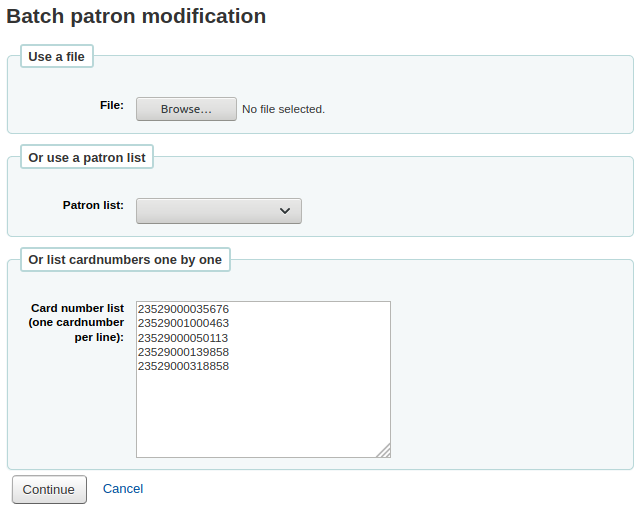
上傳檔案或掃瞄條碼後可按 『繼續』 鈕。將出現包括剛才改變的者清單。
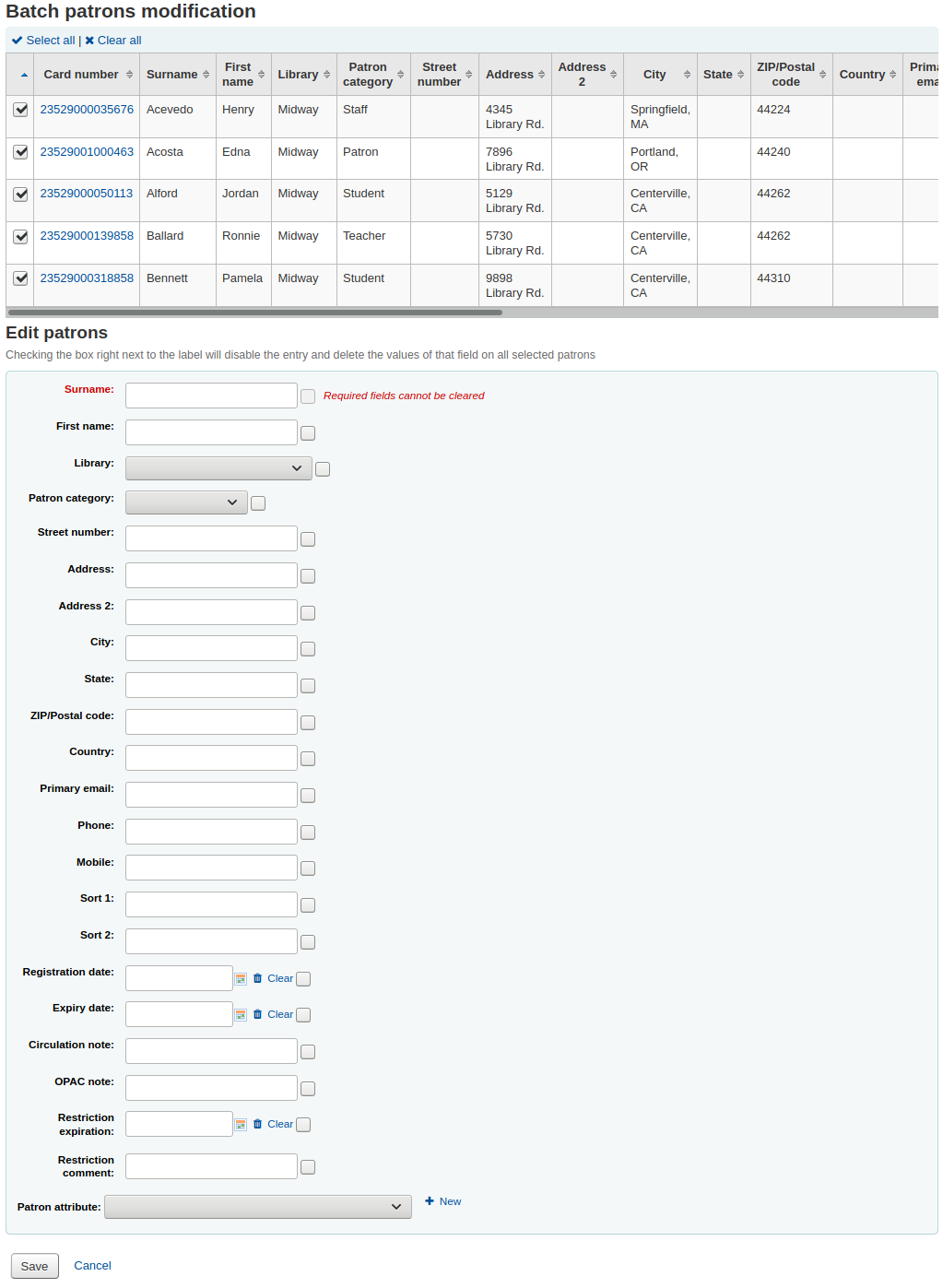
每個文字盒左邊有勾選盒。用來清除欄位裡的值。
重要
不能清除必備欄位的值。
If you have multiple patron attributes you can change them all by using the 『+ New』 link to the right of the text box. This will allow you to add another attribute value.

改變之後,勾選 『儲存』 Koha 將出現改變後的讀者紀錄。
Batch extend due dates
Get there: More > Tools > Patrons and circulation > Batch extend due dates
This tool allows you to update due dates in bulk, this can be useful if a library needs to close unexpectedly and cannot accept returns.
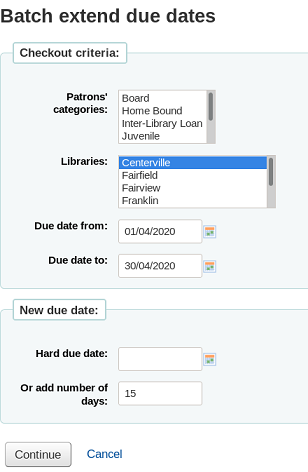
You can filter the selection of checkouts based on patron category, library or a combination of both. You can select multiple options in the dropdown lists if needed.
Next, specify a date range for the current due date of the materials on loan. For example, you may want to extend the due dates for recent checkouts but exclude long overdue loans.
Choose to extend the due dates either to a new hard due date or by a number of days. Using the number of days option can prevent large numbers of loans being due on the same date.
You can choose whether to preview the results of your selections.

If you preview the results you will see a table which shows you the current due date and the new due date so that you can check your selections. You can untick checkouts if they are incorrect or go back and change your selection.
Click on the Modify selected checkouts button to see a confirmation screen showing the checkouts that have been modified.
備註
Access to this tool requires the Tools permission batch_extend_due_dates.
Tag moderation
Get there: More > Tools > Patrons and circulation > Tags
Depending on your tagging system preferences, librarians may need to approve tags before they are published on the OPAC. This is done via the tag moderation tool. If there are tags awaiting moderation they will be listed on the main staff dashboard under the module labels:

以標籤工具管理標籤。首次使用此工具時,出現待評審的標籤清單,或被館員拒絕的標籤清單
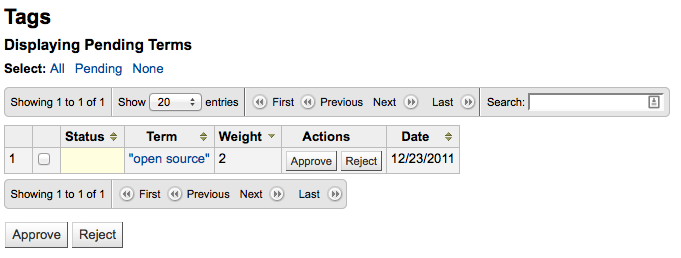
點選標籤詞彙,就可看到所有的相關題名

按題名右方的 『移除標籤』 鈕,就可以移除個別題名的標籤。
勾選個別詞彙列的 『核准』 鈕或勾選所有的詞彙再選取表單下的 『核准』 鈕,都可以核准欄號。
To reject a tag, you can either click the 『Reject』 button in line with the term, or check all terms you want to reject and click 『Reject』 below the table.
標籤被審核通過或拒絕後,將移到適當的標籤清單。所有標籤的摘要將顯示在螢幕右方。
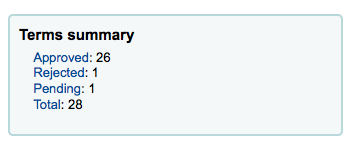
即便已通過或拒絕的標籤,仍可移至其他清單。檢視通過的標籤時,有個拒絕的選項:

在螢幕右下方的搜尋盒裡,鍵入術語,即可搜尋該術語的合法性 (或許使用指定的標籤審核 字典)
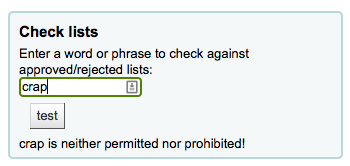
最後以左方的篩選器搜尋標籤。
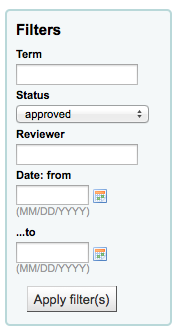
Upload patron images
Get there: More > Tools > Patrons and circulation > Upload patron images
若 允許讀者照片 附加在讀者紀錄內,就可以大批上傳讀者照片。也可用這些照片新增 讀者證。
新增文字檔,並命名為 「DATALINK.TXT」 或 「IDLINK.TXT」
每列的內容是讀者證號碼以及逗點 (或定位) 和照片檔名
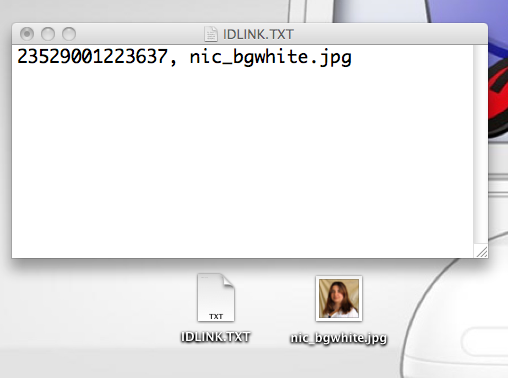
確定您TXT檔為純文字檔,不是RTF檔。
關閉文字檔與圖像檔
Go to the Upload patron images tool
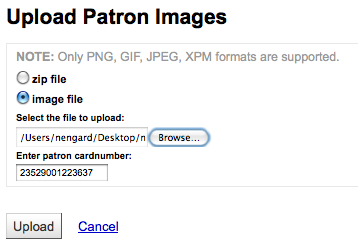
對單一照片而言,點選該照片檔案,並鍵入讀者號
多筆圖片時,選擇上傳一個壓縮檔
上傳之後,出現確認訊息
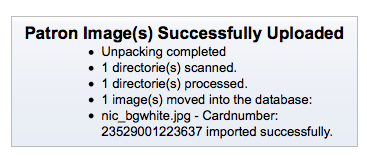
重要
每張照片的大小不能超過 100K,建議解析度不超過 200x300 圖素。
Rotating collections
Get there: More > Tools > Catalog > Rotating collections
Rotating collections is a tool for managing collections of materials that frequently get shifted from library to library. It adds the ability to store not only an item’s home library and current location but also information about where it is supposed to be transferred to next to ensure that all items in the collection are sent to the correct library. When an item in a rotating collection is checked in, library staff is notified that the item is part of a rotating collection and which branch it should be sent to if it is not at the correct one.
重要
The AutomaticItemReturn system preference must be set to 「Don’t automatically transfer items to their home library when they are returned」 for rotating collections to function properly.
To create a new rotating collection, click the 「New collection」 button, fill in the title and description, and click 「Submit」. Once submitted you’ll see 「Collection name added successfully」; click 「Return to rotating collections home」 to return to the main Rotating collections management page (or click Rotating collections in the sidebar).
To add items to a collection, click 「Actions」 and choose 「Add or remove items」 next to the collection’s name in the list of collections. Under 「Add or remove items」 scan or type in the barcode of the item you wish to add to the collection, and hit enter or click 『Submit』 if necessary.
To remove an item from a collection, either click 『Remove』 next to the item’s barcode in the list of items within the collection or check the 「Remove item from collection」 box next to the Barcode text box under 「Add or remove items」, and scan or type in the barcode, clicking 「Submit」 or hitting Enter if necessary. Note: The 「Remove item from collection」 checkbox will remain checked as long as you are on the 「Add or remove items」 page, unless you uncheck it, to facilitate quickly removing a number of items at a time by scanning their barcodes.
Transfer a rotating collection
轉移巡迴書庫將:
變更即將轉移的館藏至新的館藏地
啟動轉移程序從原位置/儲存圖書館至現在位置/儲存圖書館。收到館藏後應先還入才算完成轉移。
可以用以下的方法之一轉移巡迴書庫:
From the main Rotating collections page, click on 「Actions」 and choose 「Transfer」 next to the title of the collection you wish to transfer; choose the library you wish to transfer the collection to and click 「Transfer collection」.
Or, from the 「add or remove items」 page for a collection, you can click the 「Transfer」 button, choose the library you wish to transfer the collection to and click 「Transfer Collection」.
重要
為了完成轉移程序,應先還入至巡迴書庫的圖書館。甚狀態就不會是 「轉移中」。
若巡迴書庫的館藏被還入非巡迴書庫的圖書館,將出現提示訊息,並警示圖書館員將該館藏送至適當的地方。

Additional tools
行事曆
Get there: More > Tools > Additional tools > Calendar
Libraries can define library closings and holidays to be used when calculating due dates. You can make use of the calendar by turning on the proper system preferences:
useDaysMode: Choose the method for calculating due date - either include days the library is closed in the calculation or don’t include them
finescalendar: This will check the holiday calendar before charging fines

Adding events
新增事件前,選擇適用此閉館日的圖書館。新增事件後應選定該事件適用於單一圖書館或所有圖書館。新增事件,祗要
勾選行事曆的日期,加入終止的時間
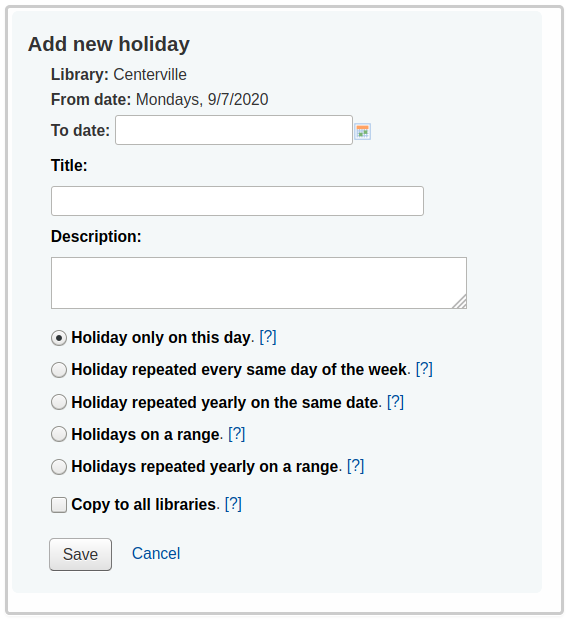
於行事曆上方的表單內,鍵入閉館資訊 (詳情請按選項右方的問號 [?])
根據從頁面上方的下拉選單選定的圖書館,圖書館將自動補入
日期資訊將根據點選的行事曆自動更新
If this holiday extends on more than one day, enter the end date in 『To date』
In the 『title』 enter the name of the holiday or the reason for the closing
In the 『description』 enter more information about this holiday
接著可選擇此事件為單一事件或重複事件。
『Holiday only on this day』: this is a one day holiday
『Holiday repeated every same day of the week』: this is a weekly closing (if you’re closed every Sunday, for example)
『Holiday repeated yearly on the same date』: this is an annual holiday closing (if you’re closed on January 1st each year, for example)
『Holiday on a range』: this is a holiday that extends on several days
說明
Make sure to enter a 『To Date』 at the top if you choose 『Holiday on a range』
『Holiday repeated yearly on a range』: this is a holiday that extends on several days each year (such as summer holidays for schools)
說明
Make sure to enter a 『To Date』 at the top if you choose 『Holiday repeated yearly on a range』
最後設定事件適用於所有圖書館或祗適用於單一圖書館
以行事曆下方的複製選單把所有假日複製至其他分館
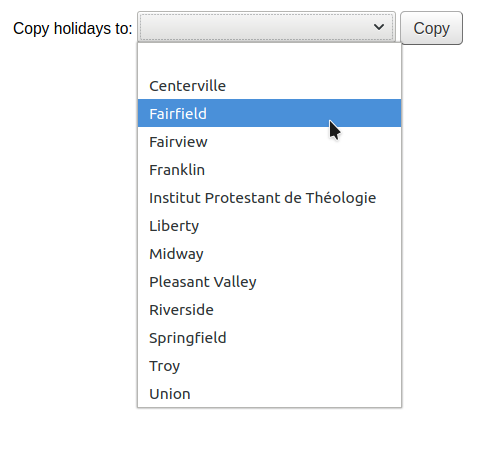
儲存之後,您可在行事曆右方看到事件清單摘要
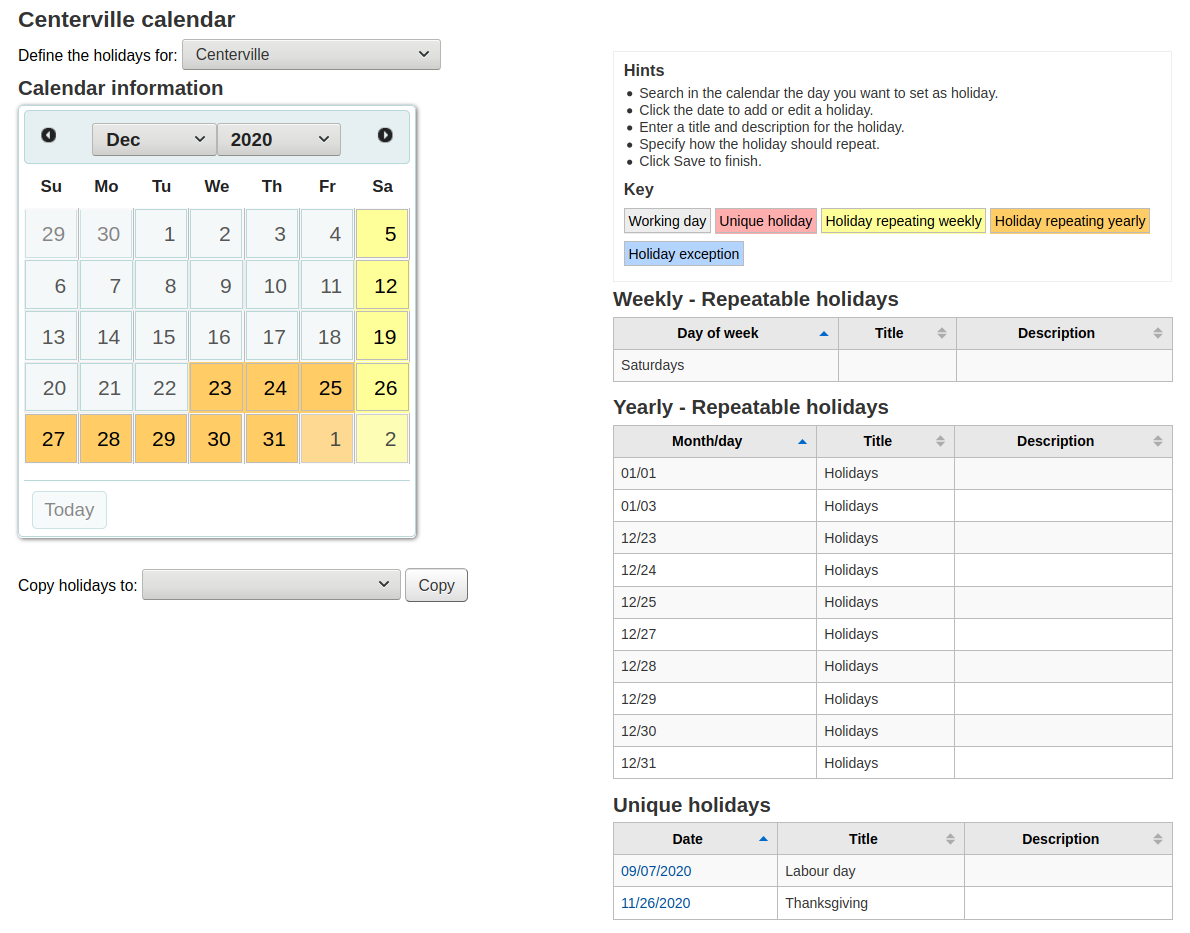
Editing events
編輯事件
勾選行事曆的事件,以改變它(勾選行事曆的日期,不是摘要)

在此表單內可以編輯或刪除假日。
必須按 『儲存』 鈕才算完成編修。
按可重複事件將出現略有不同的選項
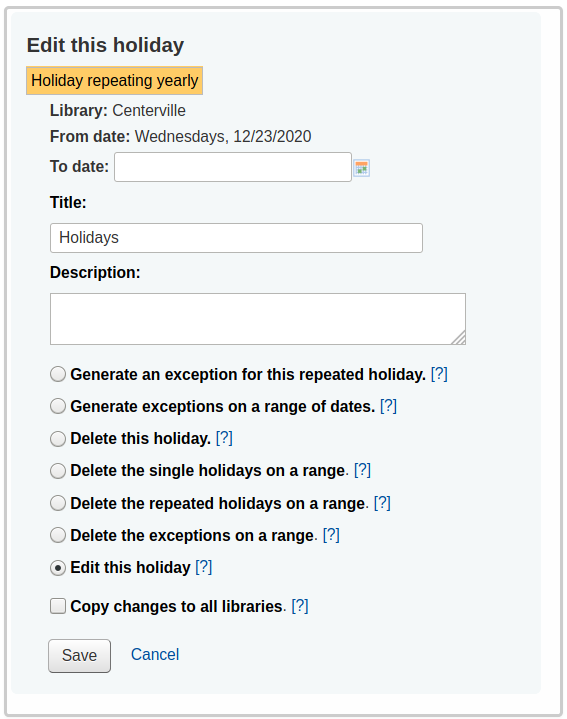
In the form above you will note that there is now an option to 『Generate an exception for this repeated holiday』 and 『Generate exceptions on a range of dates』 choosing one of these options will allow you to make it so that this date is not closed even though the library is usually closed on this date.
必須按 『儲存』 鈕才算完成編修。
Additional help
新增或編輯事件時,可以勾選表單旁的問號,取得額外的說明

CSV profiles
Get there: More > Tools > Additional tools > CSV profiles
CSV profiles are created to define how you would like your cart or list to export.
Add CSV profiles
To add a CSV profile
Click on 『New CSV profile』
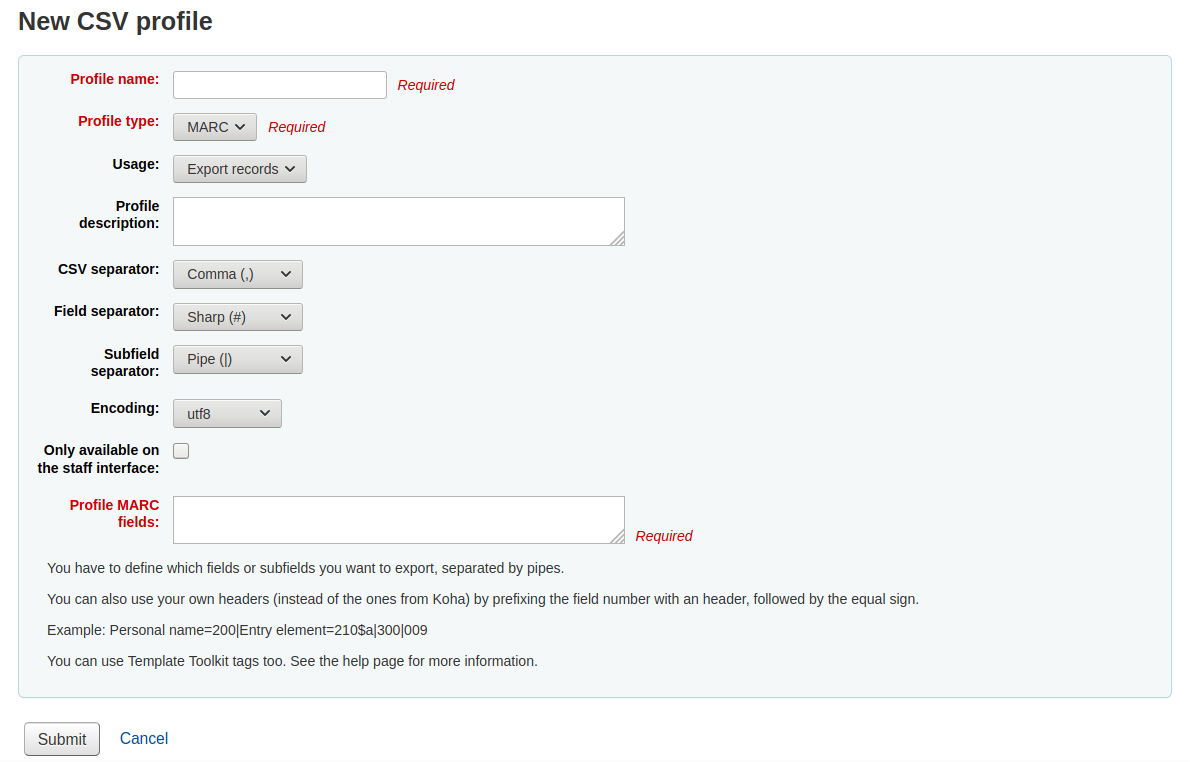
從採購單或虛擬書架裡選擇 『下載』 時,』設定檔』 名稱將顯示在匯出下拉選單

從 『設定檔類型』 決定設定的欄位類型 (MARC 或 SQL)
選擇 MARC 之後需鍵入 MARC 欄位
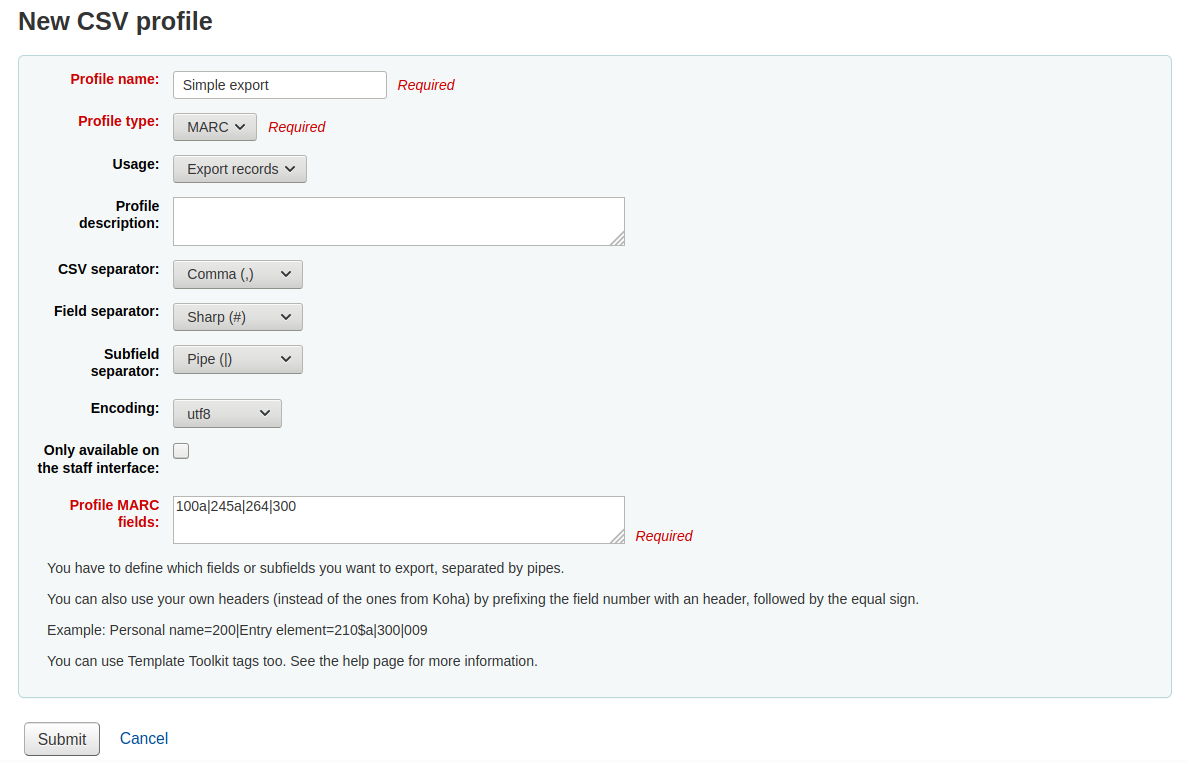
若選擇 SQL 則需鍵入 SQL 資料庫的欄位

The 『Usage』 field is used to indicate what type of report this CSV profile is used with
『Export records』 (only available with MARC profile type): this is used to export records from your cart or lists
『Late serial issues claims』 (only available with SQL profile type): this is used to export late issues of serial subscriptions
『Export late orders』 (only available with SQL profile type): this is used to export late orders in the acquisitions module
- 『Basket export in acquisition』 (only available with SQL profile
type): this is used to download records from acquisitions baskets
- 『Export lost items in report』 (only available with SQL profile
type): this is used to export a CSV from the lost items report
The 『Profile description』 is for your own benefit, but will also appear in the OPAC when patrons download content, so make sure it’s clear for your patrons as well
此 『CSV產生器』 是以字元區隔值與值的群組
說明
最常見的選項是逗點,因為大部份的試算表應用程式都能以逗點使用開放檔案。
此 『欄位區隔字元』 是用於區隔重複的欄位
例如:您可有多個650欄位,這是顯示在欄位的字元

此 『分欄區隔字元』 是用於區隔重複的分欄
何如:您可有多個$a分欄
此 『編碼』 欄位讓您設定儲存檔案時使用的編碼方式
The 『Only available on the staff interface』 checkbox (only for MARC profile types) lets you limit this CSV profile to staff interface only, meaning patrons will not be able to use this profile to export their cart or lists from the OPAC
Finally format your CSV file using the 『Profile MARC fields』 or 『Profile SQL fields』 box
Define which fields or subfields you want to export, separated by pipes. Example : 200|210$a|301 for MARC or biblio.title|biblio.author for SQL
說明
You can also use your own headers (instead of the ones from Koha) by prefixing the field number with a header, followed by the equal sign. Example: Personal name=100|title=245$a|300
When you have entered in all of the information for your profile, simply click 『Submit』 and you will be presented with a confirmation that your profile has been saved.

Modify CSV profiles
Once you have created at least one CSV profile an 『Edit profile』 tab will appear next to the 『New profile』 button.
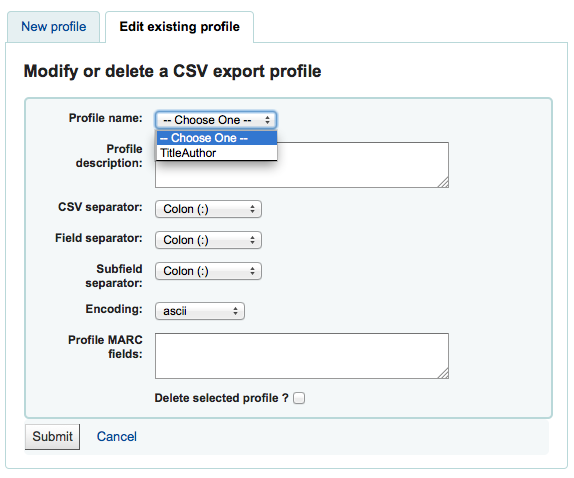
選擇編輯的設定檔,並修改必要的欄位。
送出您的改變後,在螢幕上端出現確認訊息

按下 『送出詢問』 前,勾選 『刪除選定的設定檔』 選項,就能刪除設定檔

Using CSV profiles
Your CSV profiles will appear on the export list or cart menu under the 『Download』 button in both the staff client and the OPAC
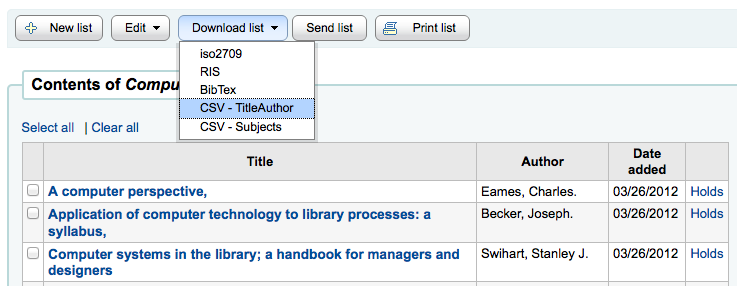
Log viewer
Get there: More > Tools > Additional tools > Log viewer
Actions within the Koha system are tracked in log files. Your system preferences can be changed to prevent the logging of different actions. These logs can be viewed using the log viewer.

備註
The warning sign next to a module name indicates that the actions in this module are not logged. Change your logs preferences to log actions from a module.
選擇選單的不同組合,以產生詢問的紀錄檔。
A query for all logs related to the Circulation module produces a result

備註
You can customize the columns of this table in the 『Table settings』 section of the Administration module (table id: logst).
最新消息
Get there: More > Tools > Additional tools > News
Koha 的最新消息模組允許館員張貼最新消息至 OPAC、館員目錄與流通收條。

To add news to either the OPAC, the staff interface or a circulation receipt:
Click 『New entry』

Code: enter a unique code for this news item
Display location: choose where to put the news
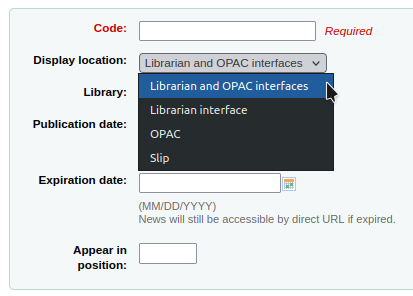
Librarian and OPAC interfaces: content will appear on the staff interface main page as well as in the news block on the OPAC
Librarian interface: content will appear on the staff interface main page
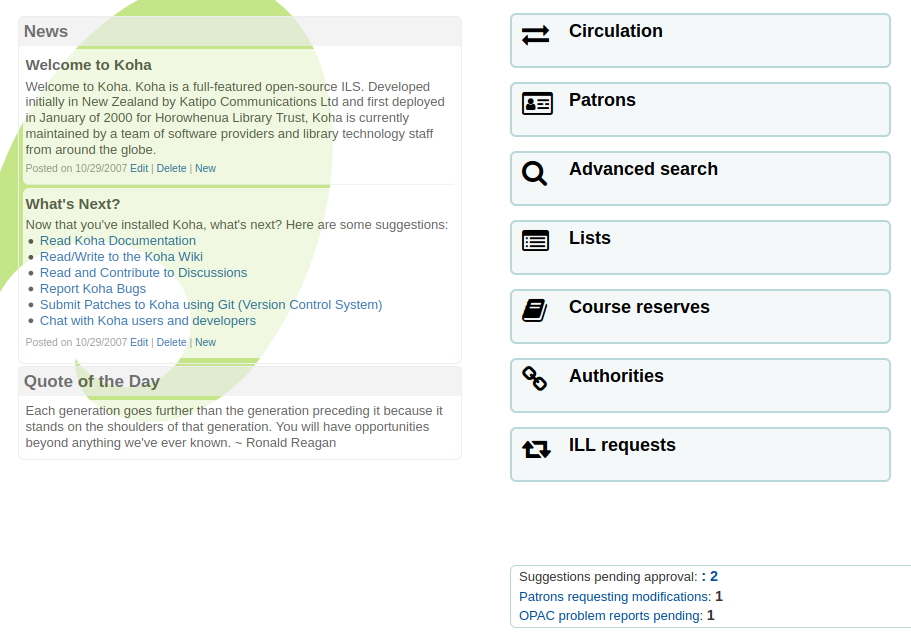
OPAC: content will appear in the top middle part of the OPAC page
Below the news in the OPAC there will be an RSS icon allowing you and your users to subscribe to library news

You can allow your users to choose to see branch-specific news with the OpacNewsLibrarySelect system preference
Slip: content will appear on the circulation receipts
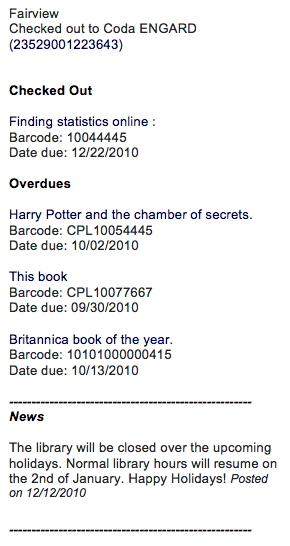
備註
This can be activated or deactivated in the Notices & slips tool
Library: choose the library for which this news item will be shown
Prior to end users logging in to the OPAC only new items listed to appear for 『All libraries』 will display unless your system administrator has configured an 『OPAC_BRANCH_DEFAULT』 override in virtual host configuration. See installation for details.
Publication date: use the publication date field to control from which date your news item appears
Examples: (these assume today’s date as 7 May 2019)
Publish on current date: set publication date as 7 May 2019
Schedule for publishing in future: set date later than 7 May 2019
Backdate the news item: set date earlier than 7 May 2019
Expiration date: use the expiration date field to automatically stop showing the news item when it is no longer relevant.
If this field is empty the news item will be shown until you remove it manually
Appear in position: you decide in what order your news items appear
If the field is left empty, the news will appear from newest to oldest
In this field, 0 is the top-most position; the larger the number, the lower in the list the news will appear
You can enter the news title and text for each language installed
備註
You can choose which type of editor to use here (either a text editor or a WYSIWYG (what you see is what you get) editor) with the AdditionalContentsEditor system preference.
鍵入資料於所有欄位後,點選 『送出』
Depending on your choice for the NewsAuthorDisplay system preference, you will also see the person who created the news item (this uses the logged in person).
HTML customizations
Get there: More > Tools > Additional tools > HTML customizations
Koha’s HTML customizations tool allows staff to post content to the OPAC.
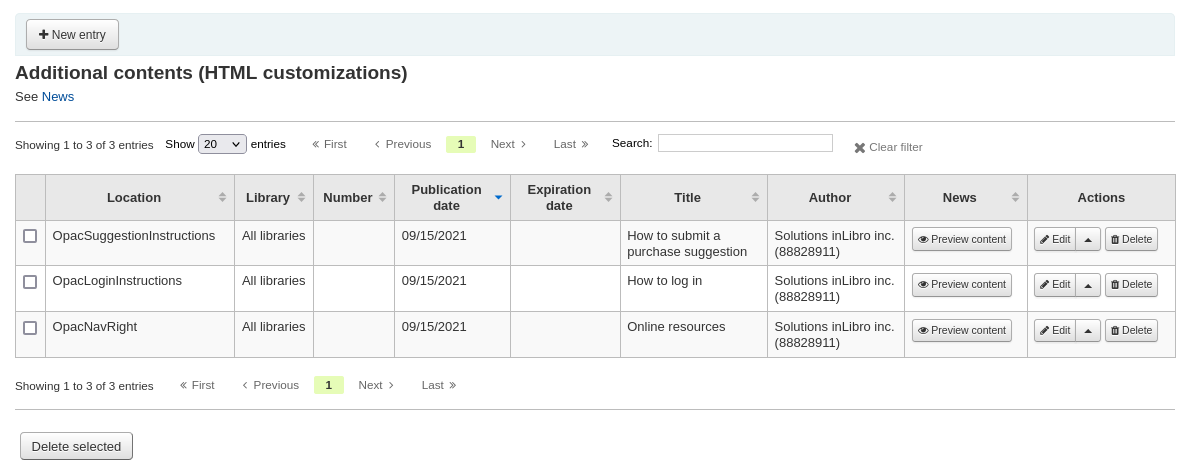
To add content to the OPAC:
Click 『New entry』
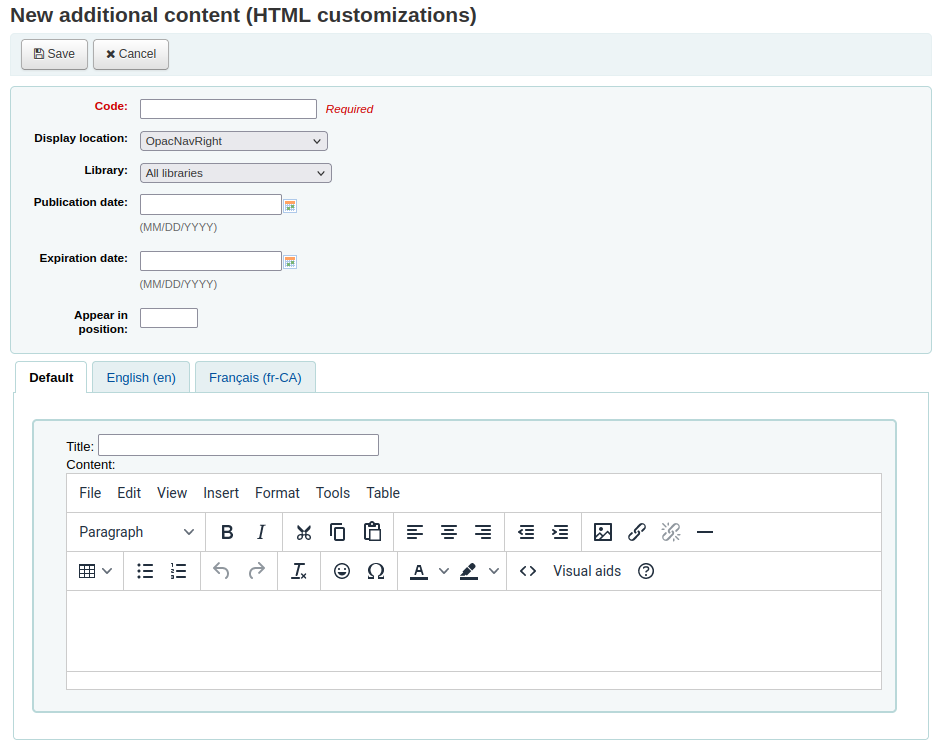
Code: enter a unique code for this additional content item
Display location: choose where to put the content
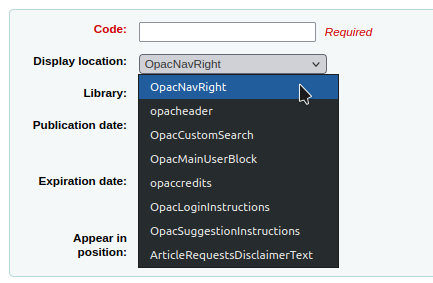
The following image shows where each block is displayed on the OPAC’s main page
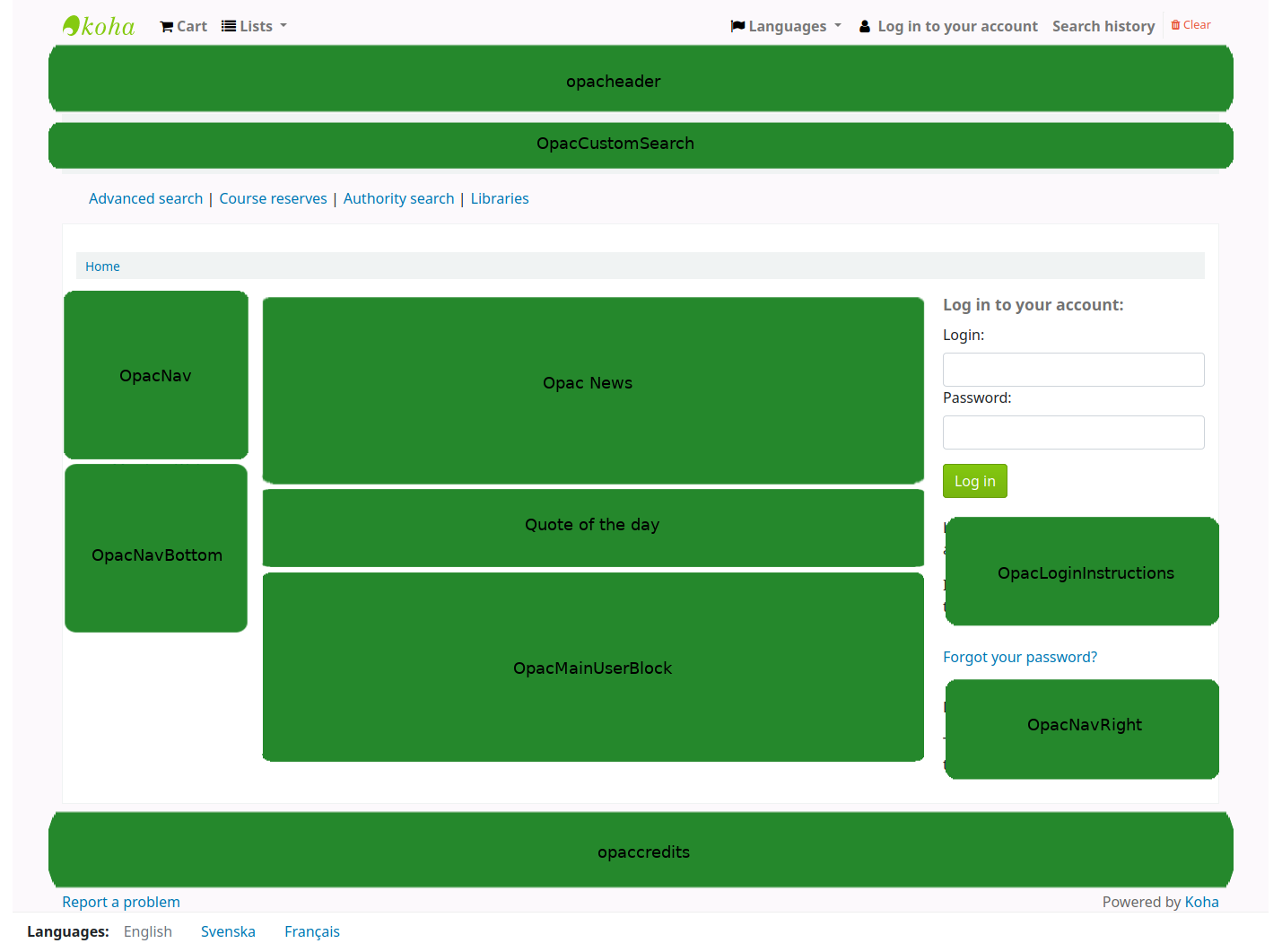
備註
OpacNav and OpacNavBottom are system preferences and the Quote of the day feature is found in the tools module. The rest of the customizable blocks are managed in the HTML customizations tool.
OpacNavRight: content will appear on the right side of the OPAC page
opacheader: content will appear at the top of the OPAC page
OpacCustomSearch: content will replace the simple search bar at the top of the page
OpacMainUserBlock: content will appear in the middle of the OPAC’s main page
opaccredits: content will appear at the bottom of the page
OpacLoginInstructions: content will appear under the login box on the OPAC’s main page
OpacSuggestionInstructions: content will replace the text at the top of the purchase suggestion form on the OPAC
ArticleRequestsDisclaimerText: content will appear and patron will have to accept before they can continue to the article request form; use for any copyright/disclaimer patrons need to be aware of regarding photocopies or scans of articles or chapters
Library: choose the library for which this content will be shown
Prior to end users logging in to the OPAC only content blocks listed to appear for 『All libraries』 will display unless your system administrator has configured an 『OPAC_BRANCH_DEFAULT』 override in virtual host configuration.
Publication date: use the publication date field to control from which date your content appears
Examples: (these assume today’s date as 7 May 2019)
Publish on current date: set publication date as 7 May 2019
Schedule for publishing in future: set date later than 7 May 2019
Backdate the news item: set date earlier than 7 May 2019
Expiration date: use the expiration date field to automatically stop showing the content when it is no longer relevant.
If this field is empty the content will be shown until you remove it manually
Appear in position: you decide in what order your content appear, when there is more than one in the same display location
If the field is left empty, the content will appear from oldest to newest
In this field, 0 is the top-most position; the larger the number, the lower in the list the content will appear
You can enter the content title and text for each language installed
備註
The title is not shown for additional content. It mostly serves to know at a glance what the content is about when looking at the list of additional content items. If you want a title to appear, you must add it in the text portion.
備註
You can choose which type of editor to use here (either a text editor or a WYSIWYG (what you see is what you get) editor) with the AdditionalContentsEditor system preference.
鍵入資料於所有欄位後,點選 『送出』
Pages
Get there: More > Tools > Additional tools > Pages
The pages tool is a tool to create custom additional pages in the OPAC and in the staff interface. It is based on the same tool as the news and the HTML customizations, therefore it works in the same way.

To add a new page:
Click 『New entry』
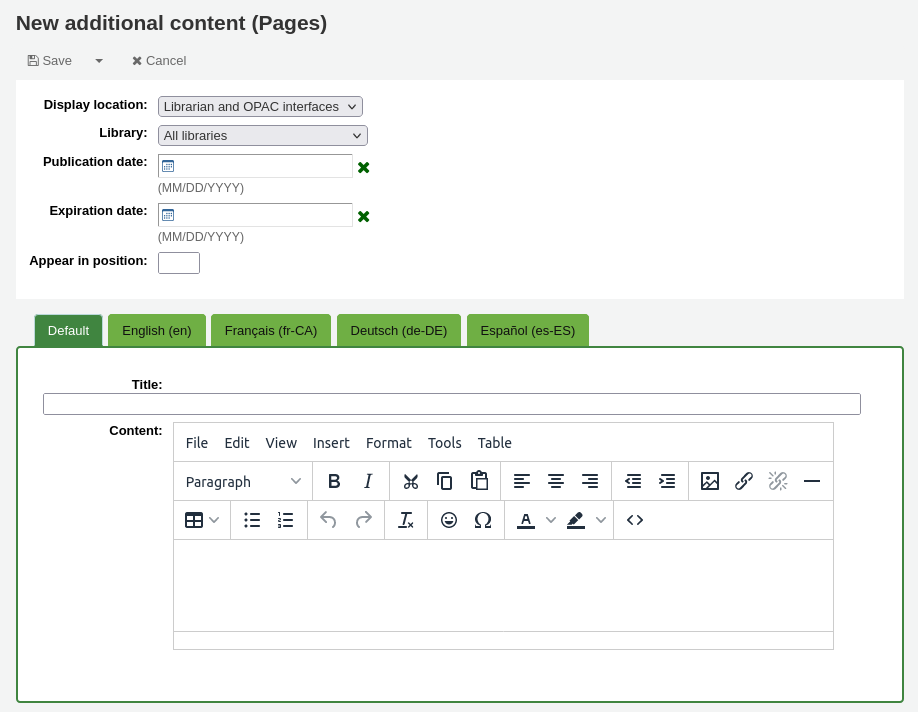
Display location: choose the interface from which this page should be accessed
Librarian and OPAC interfaces: two links will be created, one for the OPAC and one for the staff interface
Librarian interface: a link for the staff interface will be created
OPAC: a link for the OPAC will be created
Library: choose the library for which this page will be available
If an OPAC page is limited to a library, only logged in users whose home library matches the page library will be able to access the page.
Pages limited to a library will not be accessible to OPAC users who are not logged in, unless your system administrator has configured an 『OPAC_BRANCH_DEFAULT』 override in virtual host configuration.
If a staff interface page is limited to a library, only staff logged into that library will be able to access the page.
Publication date: use the publication date field to control from which date your page is accessible, if it should only be accessed at a future date.
Expiration date: use the expiration date field to remove the page after a specific date.
If this field is empty the page will be available until you remove it manually
Appear in position: this field does not affect pages, it is only used by other additional content
You can enter the page title and content for each language installed
備註
You can choose which type of editor to use here (either a text editor or a WYSIWYG (what you see is what you get) editor) with the AdditionalContentsEditor system preference.
鍵入資料於所有欄位後,點選 『送出』
In the table, a link will be generated for the OPAC or the staff interface or both. Use this link in HTML customizations, news or system preferences such as IntranetNav or IntranetmainUserBlock so that the patrons or staff members can access the new page.
Task scheduler
Get there: More > Tools > Additional tools > Task scheduler
工作排程是任何時間都可執行的報表排程。
To schedule a task, visit the task scheduler and fill in the form
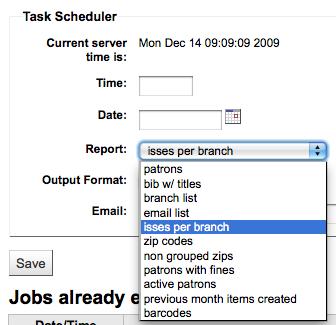
伺服器現在時間(用於管理所有的報表 - 不是真的在地時間)
時間應鍵入為時時:分分(2個數字為時,2個數字為分)
應以彈出的日曆鍵入日期
從報表選取工作的報表
選是是否收取此結果的文字或連結
在 Email 欄位鍵入接收報表者的電子郵件
工作排程表單下,有排定報表清單

按下 『排程』 連結,就可從儲存報表清單執行報表排程
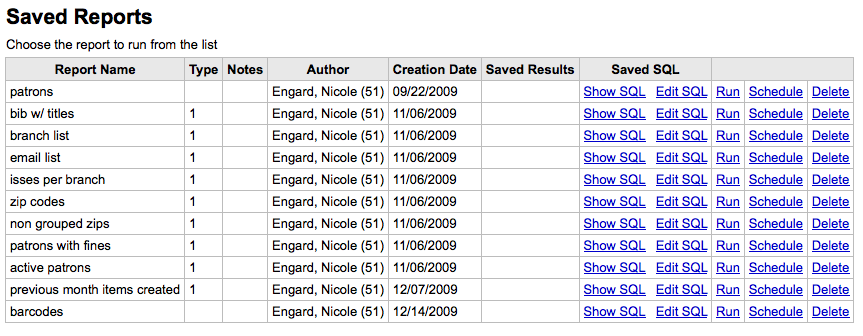
解決問題
若網站使用者沒有權限則不會執行工作排程。檢查 /etc/at.allow 查看使用者的權限。若沒有該檔案,則檢查 etc/at.deny 檔案。若 at.deny 內容為空白,則每個人都可以執行它。要求您的系統管理員把使用者加入正確的位置才能執行排定工作。
Edit quotes for QOTD feature
到那裡: 更多 > 工具 > 其他工具 > 編輯每日一句
This tool will allow you to add and edit quotes to show on the OPAC or the staff interface.
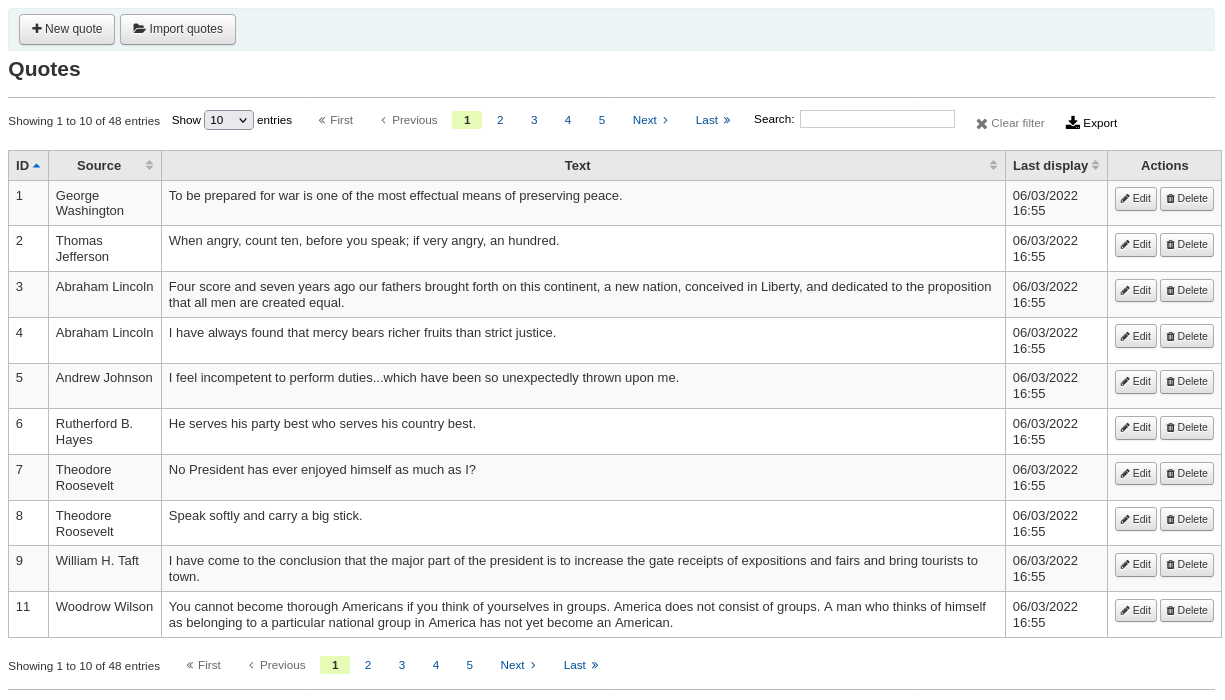
To turn this feature on set the QuoteOfTheDay system preference to either 『OPAC』, 『staff interface』, or both, and add at least one quote using this tool.
In the OPAC, the quotes will appear above the 『OpacMainUserBlock』 news block.
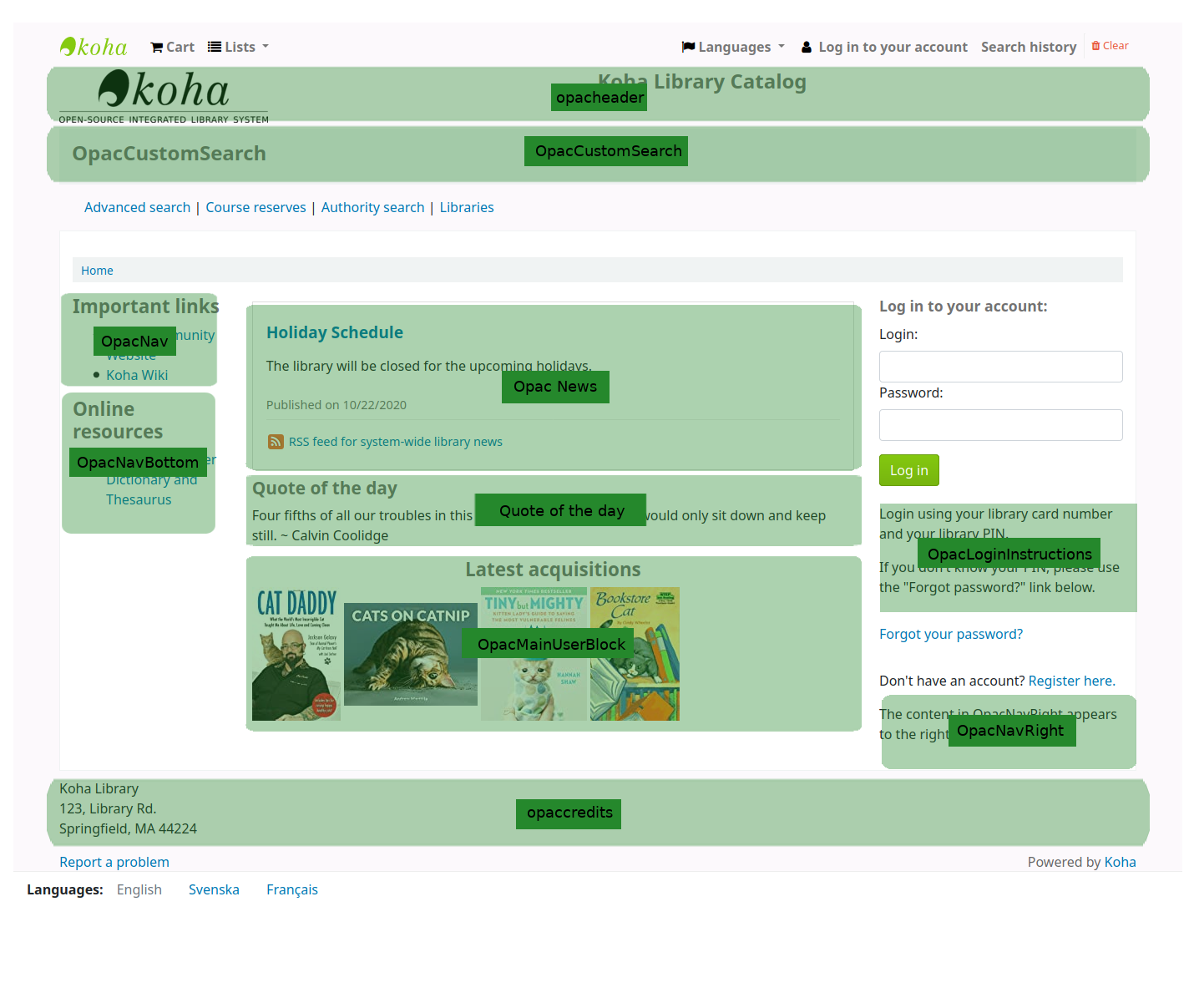
In the staff interface, the quotes will appear under the news on the left side.

Add a quote
新增引句:
Click the 『New quote』 button in the toolbar.

Fill out the form.

Source: enter the source of the quote, e.g. the name of the person who said the quote
Text: enter the text of the quote
警告
必須在 『來源』 與 『內文』 欄位鍵入資料才能儲存新的引句。
Click 『Submit』 to save the new quote.
The new quote should now be visible in the list.
Import quotes
You can import a batch of quotes as a CSV file. Your file must contain two columns in the form: 「source」,」text」 with no header row.
備註
將提示確認上傳的檔案大於512KB。
勾選螢幕上方的 『匯入引句』 鈕啟動匯入程序

進入匯入引句螢幕後可從電腦內選取欲匯入的檔案

選定CSV檔案後,點選 『開啟』 鈕,該檔案將上傳至暫存編輯表。
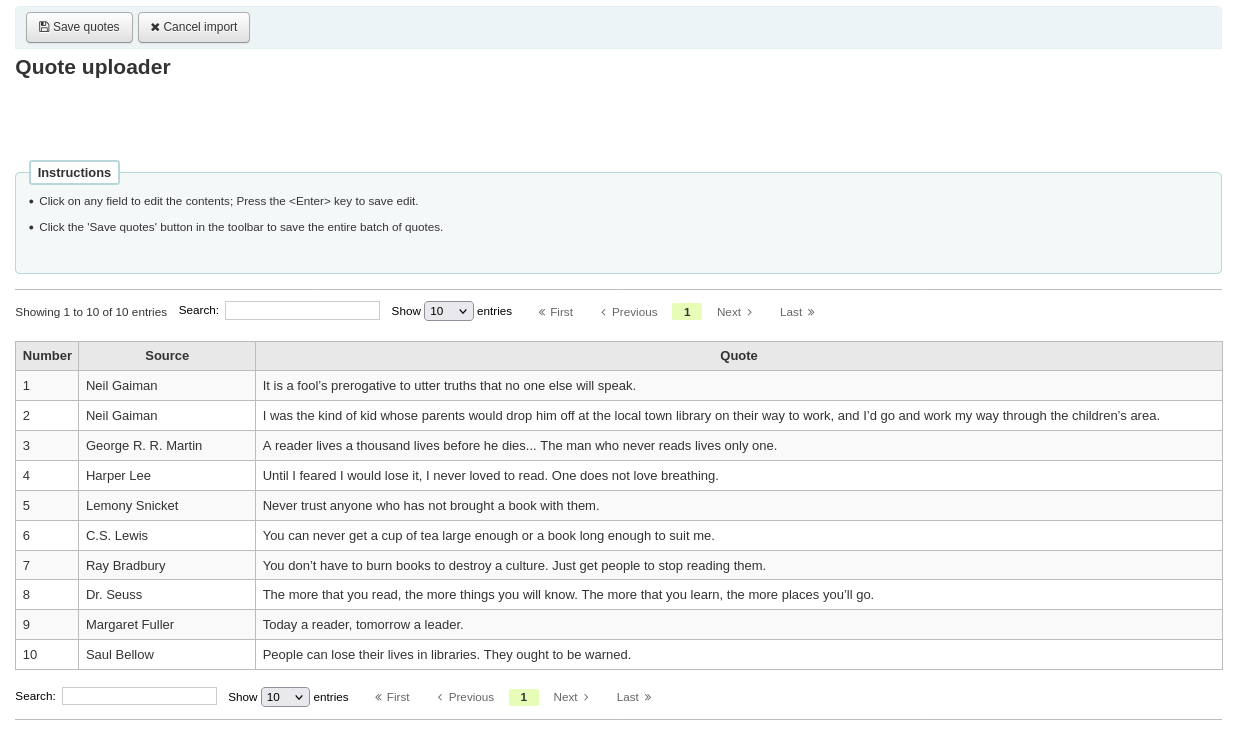
按下 『來源』 或 『文字』 欄位就能夠編輯該清單的內容。完成欄位的編輯後,按 <Enter> 鈕儲存該內容。

完成之後,按上方工具列的 『儲存引句』 鈕儲存引句。

Edit a quote
To edit a quote, click on the 『Edit』 button to the right of the quote.

Edit either the 『Source』 or 『Text』 fields.
Click 『Submit』 to save the quote.
Delete a quote
To delete a quote, click on the 『Delete』 button to the right of the quote.

Confirm the deletion by clicking 『Delete』.

上傳
到那裡: 更多 > 工具 > 其他工具 > 上傳
從 編目表單 上傳檔案供選擇。
Upload files
第一次進入上傳工具時,可能看到缺少類型的警示。
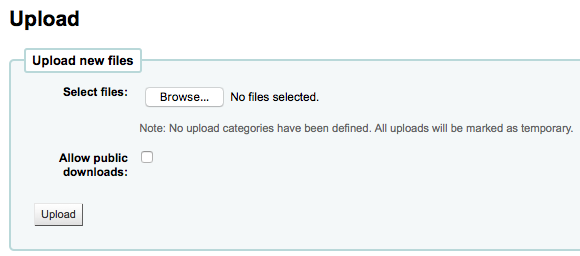
類型設定在 UPLOAD 類型的 容許值。若沒有上傳類型,則把檔案暫存,在重新啟動伺服器時將被刪除。一但在 UPLOAD 容許值類型內有了資料,可在 『瀏覽』 鈕下看類型的下拉選單。

瀏覽電腦的檔案,選擇類型並決定是否讓讀者經由 OPAC 下載。上傳之後,還有確認程序。

Search files
上傳的檔案都可以經由上傳表單搜尋。使用該表單可搜尋檔案名稱的任何部份及 Hashvalue。搜尋上傳檔案
You will be presented with the results of your search.
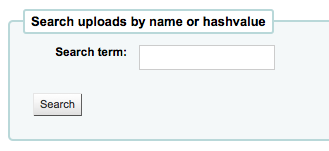
Access files
Get there: More > Tools > Additional Tools > Access files
This option allows access to files stored on the server from the staff interface. The directories where the files are stored need to be defined in the koha-conf.xml file. In order to be able to access the tool, a staff patron requires the superlibrarian or access_files patron permission

OPAC problem reports
Get there: More > Tools > Additional tools > OPAC problem reports
This tool is used to manage the problem reports sent by patrons via the OPAC.
說明
This tool only appears if you have enabled the OPACReportProblem system preference.
From this tool, you will see all the problems that were reported by patrons on the OPAC.
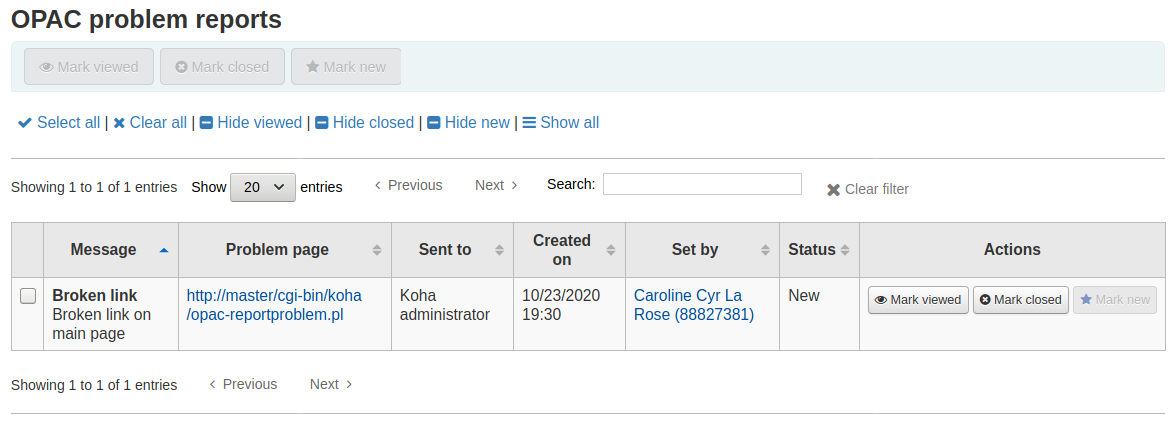
From the 『Actions』 column, you can
『Mark viewed』: mark this problem report as viewed, this will change the status of the problem report to 『Viewed』
『Mark closed』: close this problem report, this will change the status of the problem report to 『Closed』
『Mark new』: mark this problem as new (i.e. not viewed), this will revert the status back to 『New』.
You can also batch change statuses by checking the boxes next to the problem reports you want to change and use the button at the top of the page.
Cash management
Koha includes a number of options for dealing with monetary transactions and actions to allow for fine grained tracking of these processes for audit and analytic processes.
Cash registers
Cash registers can be used to track transactions to a specific location in your library. This can be especially helpful for detailing where cash has been taken for payments and then when this cash is subsequently removed and taken to the bank.
Setup
To enable the use of cash registers, you must turn on the UseCashRegisters system preference.
You can then configure cash registers for your library from the cash registers page in the administration module.
Cashup
The action of 『cashing up』 can be recorded against a cash register from both the library details and register details pages.
Clicking the Record cashup button will simply record the date and time that the action has taken place and is intended to allow the regular record of when money is collected from the cash register and taken to the bank.
Both of the above pages utilize the cashup record to limit the display of transactions/summaries to only pertinent information, since the last cashup.
Once a cashup has taken place, a summary of the transactions taken during that cashup period is available for display, and printing, via the Summary link found next to the last cashup date on the register details page.
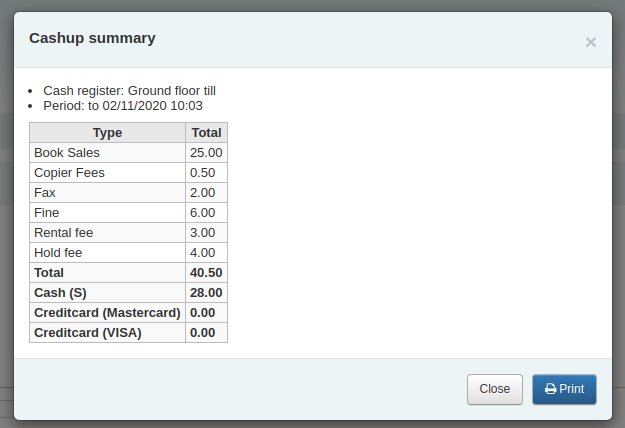
Cash summary for library
Get there: Home > Tools > Cash summary for library
A summary of transaction amounts associated to a libraries cash registers can be found under the 『Cash summary for library』 page tool.
The summary will list registers associated with your logged in branch alongside information about how much money should be found in each register, what is available to take to the bank and a breakdown of income vs outgoings.
Note: You can also access this page from the left hand menu available on the Point of sale page when that module is enabled.
Transaction history for register
Get there: Home > Tools > Cash management > Transaction history for register
A list of all transactions to have taken place at a register is available by clicking on the cash register name from the library details page.
If you have the correct permissions, you can re-print receipts, issue refunds and record cashups from this page.
Note: You can also access this page from the left hand menu available on the Point of sale page when that module is enabled.


評論
Get there: More > Tools > Patrons and circulation > Comments
讀者經由 OPAC 新增的評論都需經館員審核。待審核的評論出現在館員首頁的工具分頁之下:
and next to the Comments tool on the Tools page
To moderate comments click on the notification on the main dashboard or go directly to the Comments tool and click 『Approve』 or 『Delete』 to the right of the comments awaiting moderation.
若無評論待審核,您可看到無可審核的訊息
選擇 『通過審評』 分頁,就能檢視或拒絕曾經通過的評論